|
Preface
Hello
and welcome to the Military and Paramilitary Flags of Singapore site, part
of Herman's Mainframe. I am a budding vexillologist; and this page is
dedicated to and also to celebrate the much overlooked vexillological
scene of Singapore. Vexillology is the study of flags - the
design, history, protocols, significance, commonality, etc of flags. Vexillologists
are people who study about flags. To learn more about vexillology, the Flags
of the World (FOTW) website (and the mailing list) is a good starting
point from where I
have learnt much from other more experienced vexillologists. Around the
world, there also exist various vexillological associations dedicated to
this field of study.
The
Military & Paramilitary Flags & Ranks of Singapore site is not an
official site of any of the Singapore services mentioned in these pages,
but I do hope that the information here would be helpful and informative.
There are quite a number of images to appear, so please allow some time
for them to load. Due to bandwidth limits, the site may at times be
temporarily inaccessible. These pages are works-in-progress and as such, there
might be some unintended errors as well as missing or incomplete
information. Do e-mail me if there is information that requires
correction, additional information, and/or other comments if any.
The
site relating to flags consists of two pages. Page 1 (current page) is about the
general flags of the services while Page
2 deals with the ceremonial flags of the services. You may click
on the <Chapter
headings> or
<Sectional
titles> on the Directory list on the left for a
direct referral to the sections. To return to the Directory, you may click
on the [Return to
Directory] links available at the end of each section
throughout the pages.
These
pages use quite a number of vexillological terminologies. If a glossary is
required, please refer to FOTW:
Glossary of Flag Terms website for a comprehensive list and their
definitions. I am also interested in Heraldry, the art and science of coat
of arms, thus I have used heraldic terms where it is appropriate. Heraldry
and vexillology while separable are but inter-related and this page will
thus also explore a little on Singapore's coats of arms. The different
parts of the
various arms of Singapore were used by the services which in turn appears
on the flags of the services where necessary.
i - Service
Classifications:
The
flags presented on these pages are those of
Singapore’s military and paramilitary services. Some elaboration on this
issue is provided before proceeding as it affects the selection of
organisations to be represented here. The ‘military’ would refer to
the armed services, which is comprised of the Army, the Navy and the Air
Force. The three armed services of Singapore is a unified force under the
name 'Singapore Armed Forces' (SAF). The SAF is under the jurisdiction of
the republic’s Ministry of Defence (Mindef).
The
term ‘paramilitary’ has quite a few definitions, the simplest being
"a group of civilians organised in a military fashion". "Military
fashion" is understood to be with regards to the hierarchy (structure)
resembling that of the armed forces, as well as the presence of
regimentation and discipline in training and conduct manifested in the use
of uniforms and drills. For these pages, organisations are limited to
official government agencies. The purpose and functions of such
organisations are mainly with regards to internal security and law
enforcement, and if need be, these agencies complement the duties of the
armed forces. The armed forces may also assist these home-front services if
and where it may be necessary.
By
the aforesaid framework, the Singapore Civil Defence Force (SCDF) and the
Singapore Police Force (SPF) are paramilitary organisations. The reference
of these two forces as paramilitary organisations is briefly mentioned in
Tim Huxley’s work, Defending the Lion City. I would also, by the
above-mentioned framework, include the Singapore Prison Service (SPS) as
they have such features. Tim Huxley also classified the National Cadet
Corps as a paramilitary organisation in his book although it was not
extended to the Police Cadet Corps. I will therefore by the same
framework also include the various national cadet corps, the land-air-sea
cadets, police cadets and civil defence cadets, as paramilitary
organisations.
Apart
from the Police, there are other government agencies that are granted the
authority to do enforcement work in specialised areas. With the exception
of the Prisons department, these other organisations do not fit perfectly
into the given paramilitary definition framework as they fulfill the
criteria only partially. Such organisations include the Internal Security
Department (ISD), the Central Narcotics Bureau (CNB), the Immigration
& Checkpoints Authority (ICA), and the Singapore Customs. Personnel
from the ISD and CNB do not don uniforms, however, a rank structure does
exist in these departments. The ICA and Customs are uniform-wearing services with
rank structures but regimentation is not a feature of these two services.
For ease of reference, these agencies have been referred to generally as
the "other enforcement services" and for inclusiveness, their flags
have been included where information is available.
Singapore
Customs is a department under the Ministry of Finance. The SCDF, SPF, SPS,
ISD, CNB, and ICA are departments under the Ministry of Home Affairs (MHA)
and are collectively referred to as the ‘Home Team’. MHA
regards the SCDF, SPF, SPS, and CNB as the ‘Home Affairs Uniformed
Services’ (HUS). To add on to the classification fluidity, with
regards to the protection of Singapore’s sovereignty where "[t]here
shall be … no relinquishment of control over the Singapore Police Force
or the Singapore Armed Forces … ", the definition of Singapore Armed
Forces in the article's context comprises the SAF as well as the SCDF
(Constitution of the Republic of Singapore - Part III, paragraphs 6.1b
& 6.2). Where mandatory National Service (NS) is concerned, conscripts
can be posted to the Army, Navy, Air Force, Police, and/or Civil Defence
forces for their NS duties.
The
rank structures and insignias of these various services is presented and
compared at the Military
& Paramilitary Ranks of Singapore page. Military Defence and
Civil Defence are two of the five components of "Total Defence" and is
provided for by the military and paramilitary services of Singapore. Visit
the Total Defence
website to learn more.
The
various national cadet corps to be mentioned on these pages constitute as
only some of the many Uniformed Youth Organisations (UYO) that exists in
Singapore. Only the national cadet corps have been included in these pages
as they are associated with the main military and paramilitary
organisations of Singapore (SAF, SPF, & SCDF). To be noted is that
other UYOs also have rich flag histories and practices, some of which are
international in practice. Much information and discussion on them is
available at the FOTW web sites, for example the flag practices of St
John’s Ambulance Brigade.
ii
- General History of Singapore & Malaya/Malaysia:
Besides
presenting the current flags of the various services in Singapore, also
included are notes on historical flags of the services where such
information is available. It is helpful and interesting to know the
historical flags as they have influenced the present day flags in many
ways. As such, a very general knowledge on the history of Singapore
(and Malaya/Malaysia) would be very helpful. The chronology here only
highlights the events of the colonial period up to independence and the
major developments in the usage of symbols and flags that came along with
these changes:
1798,
1819, and 1824: Penang (1798) and Singapore (1819) were
established as British ports. Malacca was obtained after the signing of
the Anglo-Dutch Treaty of 1824.
1826:
Formation of the British Straits Settlements, comprising the three
acquired British ports. In 1907, Labuan was incorporated. On 1st April 1867, the
Colony of the Straits Settlements became a Crown Colony, whereby it was governed directly from
London rather than through administrators of British India under the
previous arrangement.
 The
British Union Flag was the official flag of the Straits Settlements. The
Straits Settlements also had a blue colonial ensign defaced with a badge.
Its use spanned from 1826 to 1946 (World War II: Japanese Interregnum 1942
to 1945). The badge of the Straits Settlements was a red lozenge, charged with a white inverted pall
- a heraldic charge in the form of the letter 'Y'. On each arm is charged an
imperial crown. The badge was used for government purposes but was
not officially authorised however. This
blue ensign charged with this badge was used as the naval ensign of the Straits Settlements
Royal Naval Volunteer Reserve.
This colony badge was used in the service badge of the Straits Settlements
Police and the service badge of the Straits Settlements Royal Naval
Volunteer Reserve. The blazon of this device was as follow:
Gules, on a pall reversed argent, three imperial crowns one and two or.
This badge placed at the centre of the Union Flag was the flag of the
Governor of the Straits Settlements. The
British Union Flag was the official flag of the Straits Settlements. The
Straits Settlements also had a blue colonial ensign defaced with a badge.
Its use spanned from 1826 to 1946 (World War II: Japanese Interregnum 1942
to 1945). The badge of the Straits Settlements was a red lozenge, charged with a white inverted pall
- a heraldic charge in the form of the letter 'Y'. On each arm is charged an
imperial crown. The badge was used for government purposes but was
not officially authorised however. This
blue ensign charged with this badge was used as the naval ensign of the Straits Settlements
Royal Naval Volunteer Reserve.
This colony badge was used in the service badge of the Straits Settlements
Police and the service badge of the Straits Settlements Royal Naval
Volunteer Reserve. The blazon of this device was as follow:
Gules, on a pall reversed argent, three imperial crowns one and two or.
This badge placed at the centre of the Union Flag was the flag of the
Governor of the Straits Settlements.
 On
25th March 1911, the Arms of the Colony of the Straits Settlements was
granted by warrant. The Arms was comprised of a quartered shield bearing the following
charges representing each settlement in the following order: On
25th March 1911, the Arms of the Colony of the Straits Settlements was
granted by warrant. The Arms was comprised of a quartered shield bearing the following
charges representing each settlement in the following order:
First
quarter: Singapore (a gold lion passant guardant on a white tower all on a
red field), second quarter:
Penang (an Areca palm - Pinang or Betel nut palm), third quarter: Malacca (a
sprig of leaves and fruits of the keruing tree), and
fourth quarter: Labuan (a depiction of a schooner headed towards Mount Kinabalu
- or Borneo - at sunrise)
The
crest for the arms is a gold demi-lion rampant guardant holding a staff
from which flies a
blue banner charged with three imperial crowns. The arms as illustrated
here were shown in the Singapore Annual Reports with a red and gold
mantling. The crest appears on a wreath of gold and red placed above a
silver helm with a closed visor, a helmet used by esquires, gentlemen, and
corporations. The arms,
specifically the shield portion only, was used on the Regimental Colours of the Straits
Settlements Volunteer Force. Occasionally, a simpler depiction of the
achievement of arms was adopted showing only the shield with charges and
crest. The formal heraldic blazon for the arms and crest of the Colony of
the Straits Settlements was as follow:
Quarterly, the first quarter gules, issuant from the base a tower proper, on the battlements thereof a lion passant guardant or; the second quarter argent, on a mount an areca nut palm tree proper; the third quarter also argent a sprig of the oil tree kruing proper ; the fourth quarter azure in base on waves of the sea in front of a representation of the sun rising behind a mountain, a sailing yacht in full sail to the sinister, all proper.
Crest — A demi-lion rampant guardant supporting in the paws a staff proper, thereon flying to the sinister a banner azure, charged with three imperial crowns or.
 It
was mentioned in several sources that the Singapore Municipal Commission
used a device to represent themselves in the form of a lion statant with a
coconut palm tree all on a green turf as illustrated here on the right.
The origins and status of this badge is however unclear. It was referred
to as the Crest of the Municipal Commission often but there does not seem
to be any arms (shield and charges) for the Commission. Nonetheless, this emblem was also adopted
in the badge of the
Singapore Volunteer Corps from 1928 onwards. It was retained after the war as the crest of the new City of Singapore Arms
granted in 1948 as shown below. The lion statant (both paws grounded) was
however changed to a lion passant (a paw raised) depiction. The Singapore Volunteer Corps
Regimental Colour of 1954 featured this device with the lion that was
adopted remaining at statant position. It
was mentioned in several sources that the Singapore Municipal Commission
used a device to represent themselves in the form of a lion statant with a
coconut palm tree all on a green turf as illustrated here on the right.
The origins and status of this badge is however unclear. It was referred
to as the Crest of the Municipal Commission often but there does not seem
to be any arms (shield and charges) for the Commission. Nonetheless, this emblem was also adopted
in the badge of the
Singapore Volunteer Corps from 1928 onwards. It was retained after the war as the crest of the new City of Singapore Arms
granted in 1948 as shown below. The lion statant (both paws grounded) was
however changed to a lion passant (a paw raised) depiction. The Singapore Volunteer Corps
Regimental Colour of 1954 featured this device with the lion that was
adopted remaining at statant position.
1942 -
1945:
Second World War & Japanese Occupation of Singapore (Syonan-to)
The
Japanese "Rising Sun" Flag was the official flag of Singapore
and Malaya.
1946:
Crown colony status for Singapore and the formation of the Malayan Union
The
British returns and forms the Malayan Union (comprising of the four
Federated Malay States, other unfederated states of the Malay peninsula
and the Straits Settlements of Penang & Malacca). Singapore was
excluded from this arrangement and was governed separately. The Malayan
Union was reorganised later in 1948 to become the Federation of Malaya.
 The
coat of arms for the City of Singapore was granted by letters
patent on 9th April 1948. It featured the gold lion passant guardant on
a white tower as per the first quarter of the Arms of the Straits Settlements.
There appears a gold chief partitioned by embattlement, on which is
charged a pair of blue wings between two blue anchors, representing the trade
hub role of Singapore. The Arms of the City
used the crest of the Singapore Municipal Commission, a lion statant with a palm
tree. On the new city arms' crest however, the lion was depicted as a lion
passant (a paw raised) and not in statant (both paws on ground) position. There was also a yellow motto-scroll inscribed with
"Majulah Singapura" ("Let Singapore Flourish") probably added later. This became the motto and title of the
national anthem of the present Republic. The arms as illustrated here were
shown in the Singapore Annual Report with an all-blue mantling, and an
esquire's silver helm. The wreath for the crest was depicted in
blue. The lion passant and coconut palm crest was used in the cap badge of the Singapore
Fire Brigade and Auxiliary Fire Service placed on the traditional emergency services
starburst and was used for quite sometime after independence as well. There
were also instances where the Singapore Fire Brigade used a lion statant
guardant (both paws grounded and head turned to face viewer) with the palm
tree rather than the lion passant, notably for the badge on the fire helmet. The
colonial prison service used as part of their badge the crest but
replacing the lion passant with the lion passant guardant (a paw raised
and head turned to face viewer) like the lion as depicted on the shield. The
coat of arms for the City of Singapore was granted by letters
patent on 9th April 1948. It featured the gold lion passant guardant on
a white tower as per the first quarter of the Arms of the Straits Settlements.
There appears a gold chief partitioned by embattlement, on which is
charged a pair of blue wings between two blue anchors, representing the trade
hub role of Singapore. The Arms of the City
used the crest of the Singapore Municipal Commission, a lion statant with a palm
tree. On the new city arms' crest however, the lion was depicted as a lion
passant (a paw raised) and not in statant (both paws on ground) position. There was also a yellow motto-scroll inscribed with
"Majulah Singapura" ("Let Singapore Flourish") probably added later. This became the motto and title of the
national anthem of the present Republic. The arms as illustrated here were
shown in the Singapore Annual Report with an all-blue mantling, and an
esquire's silver helm. The wreath for the crest was depicted in
blue. The lion passant and coconut palm crest was used in the cap badge of the Singapore
Fire Brigade and Auxiliary Fire Service placed on the traditional emergency services
starburst and was used for quite sometime after independence as well. There
were also instances where the Singapore Fire Brigade used a lion statant
guardant (both paws grounded and head turned to face viewer) with the palm
tree rather than the lion passant, notably for the badge on the fire helmet. The
colonial prison service used as part of their badge the crest but
replacing the lion passant with the lion passant guardant (a paw raised
and head turned to face viewer) like the lion as depicted on the shield.
 On
13th September 1948, a Royal Warrant was issued granting a coat of
arms to the Colony of Singapore. The shield featured a gold lion passant
guardant on a tower like those appearing on the first quarter of the
1911 Straits Settlements' Arms (Gules, issuant from the base a tower proper, on the battlements thereof a lion passant guardant
or). The crest of the Straits Settlements was
retained but the banner that was attached to the staff held by the gold demi-lion rampant guardant
was changed to one with a red inverted pall charged with a single
crown all on a white field (used as the new badge of the colony as noted
in the following paragraph). The arms as illustrated here were shown in the
Singapore Annual Reports with a red and gold mantling, and an esquire's
silver helm. The wreath for the crest is gold and red. The lion on a tower
was used in the cap badge of the Singapore Infantry Regiment upon
inception before the present day armed forces badge was adopted. The
colonial Singapore Civil Defence Corps also used the shield in their
service badge. The various colonial arms of Singapore never featured
supporters in their achievement. The lion passant guardant on a tower appears on the gold buttons as used on
the present-day military's ceremonial dress. On
13th September 1948, a Royal Warrant was issued granting a coat of
arms to the Colony of Singapore. The shield featured a gold lion passant
guardant on a tower like those appearing on the first quarter of the
1911 Straits Settlements' Arms (Gules, issuant from the base a tower proper, on the battlements thereof a lion passant guardant
or). The crest of the Straits Settlements was
retained but the banner that was attached to the staff held by the gold demi-lion rampant guardant
was changed to one with a red inverted pall charged with a single
crown all on a white field (used as the new badge of the colony as noted
in the following paragraph). The arms as illustrated here were shown in the
Singapore Annual Reports with a red and gold mantling, and an esquire's
silver helm. The wreath for the crest is gold and red. The lion on a tower
was used in the cap badge of the Singapore Infantry Regiment upon
inception before the present day armed forces badge was adopted. The
colonial Singapore Civil Defence Corps also used the shield in their
service badge. The various colonial arms of Singapore never featured
supporters in their achievement. The lion passant guardant on a tower appears on the gold buttons as used on
the present-day military's ceremonial dress.
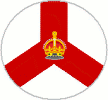 A new badge to be used on the colonial ensign was thus
granted as well. It was basically a revision of the Straits Settlements
lozenge badge. The colour order was reversed - now bearing a white field
with a red pall reversed, the overall shape of the badge changed from a lozenge to a disc, and the number of crowns reduced from three to one. The blue ensign with the new badge was used henceforth until 1959,
when Singapore attained self-government status. The crowns featured on the
colonial ensigns should have been changed from the previously used
imperial (also known as Tudor) design to the current St Edward's design
by order of Her Majesty Queen Elizabeth II in 1953. The flag featuring the
new badge was used as
the naval ensign of the Malayan Royal Naval Volunteer Reserve and the
Malayan Naval Force. The Marine Police also flew the blue ensign charged
with this badge on their vessels. The colonial police force of
Singapore accordingly updated their former Straits Settlements Police service badge
upon the change of the colonial badge but only slightly. A new badge to be used on the colonial ensign was thus
granted as well. It was basically a revision of the Straits Settlements
lozenge badge. The colour order was reversed - now bearing a white field
with a red pall reversed, the overall shape of the badge changed from a lozenge to a disc, and the number of crowns reduced from three to one. The blue ensign with the new badge was used henceforth until 1959,
when Singapore attained self-government status. The crowns featured on the
colonial ensigns should have been changed from the previously used
imperial (also known as Tudor) design to the current St Edward's design
by order of Her Majesty Queen Elizabeth II in 1953. The flag featuring the
new badge was used as
the naval ensign of the Malayan Royal Naval Volunteer Reserve and the
Malayan Naval Force. The Marine Police also flew the blue ensign charged
with this badge on their vessels. The colonial police force of
Singapore accordingly updated their former Straits Settlements Police service badge
upon the change of the colonial badge but only slightly.
On
many government publications such as reports and commissions, the Royal
Arms of the United Kingdom of Great Britain and Northern Ireland (the
simpler achievement of Arms used by HM Government) was used like those
seen on British passport covers today. The more complex Royal Arms, fully
depicted with royal helm, crest, and mantling, is used by the sovereign. On the
Arms for use by HM Government, these are substituted with a large St
Edward's or Imperial/Tudor crown.
1957:
Independence of the Federation of Malaya
The
first version of the present-day Malaysian flag was adopted as the
national flag for Malaya. The Malayan flag of 1957 to 1963 only had 11-points for the
star and 11-stripes. The flag was however already in existence since 1950.
Malaya also had their federal arms. The shield had six quarterings, one
(further divided into four) for the four former Federated Malay States, one for Penang, and one for Malacca. A red chief
is charged with five gold Malay daggers (the
keris). said to represent the five unfederated Malay states. Tigers
rampant were used as supporters of the shield of arms. The crescent and
eleven-pointed star formed the crest. Singapore remained a British colony.
1959:
Singapore attained internal self-government (known as the State of
Singapore)
 Singapore
was allowed to have a new (the present) flag and coat of arms, which were
adopted in December of that year (components detailed in Part
ii of Chapter 2 below). The Singapore State Marine Ensign was
tabled a year later in the Legislative Assembly. The British Union Flag
& colonial ensign remained in use for certain purposes. (E.g. as the
naval ensign and jack) Singapore
was allowed to have a new (the present) flag and coat of arms, which were
adopted in December of that year (components detailed in Part
ii of Chapter 2 below). The Singapore State Marine Ensign was
tabled a year later in the Legislative Assembly. The British Union Flag
& colonial ensign remained in use for certain purposes. (E.g. as the
naval ensign and jack)
1963:
Singapore
was granted independence from the United Kingdom as a constituent state of
the Malayan federation. British North Borneo (Sabah) and British Sarawak
were also granted independence as part of the federation. The new
federation was renamed Malaysia.
The
Malayan Flag in use since 1957 was updated to one bearing a 14-pointed
star and 14-stripes to denote the addition of the three new member states.
Singapore's flag of 1959 became the sub-national flag of the Malaysian state of
Singapore. The Malaysian Federation Flag became the national flag of
Singapore. (See Malaysian flag at Section 2.3D.VI on this
page). The federal Arms of Malaysia incorporated Singapore's arms -
the crescent and
stars on a red field - as one of the quarters on the shield. Sabah and Sarawak were
also represented with their own quarters on the federal arms. There were
now nine quarters on the shield.
1965: Singapore seceded
from the Malaysian federation (Republic of Singapore)
The Singapore flag of 1959 became
the national flag of the present republic. The coat of arms of 1959 became
the national coat of arms / the State Arms. The Malaysian flag was not
altered with the secession but the Singapore quarter on the Malaysian arms
was changed.
[Return
to Directory] |
|
- Chapter 2
-
The Military & Paramilitary Service, Unit, and Maritime
Flags |
|
i - General
Overview
While
the term "Flag" is the generic term used for all
types of flags, it is necessary to distinguish the various types in
Vexillology. Here, the commonly seen and daily-used flags of the services
are presented. They are primarily adopted to be hoisted and displayed
outdoors and consists of the following:
Service
Flags are
flags used to denote, differentiate, and represent the different services within the military or paramilitary groupings. These are
flags flown on a daily basis by the respective services at their various
installations alongside the national flag. A possible alternative would be
to term them "Organisational Flags" (which would be rather
general as it may include flags of any organisation) or "Command
Flags" of which the latter is perhaps more applicable to the commands
of the armed forces (e.g. Air Command, Maritime Command).
Unit
/ Formation Flags
are flags that represent the units or formations of a particular service.
Usually flown exclusively at their own premises or camps, they are next in
rank to the Service Flag. Alternative terms would include "Camp
Flags". Some services are more profound in the use of such flags
through official standardisation in their use, and certainly unofficial
ones do exist too, adopted at the discretion of the units themselves.
Maritime
Flags
consists of flags developed for use at sea. They include the Naval Jacks
(in some countries, Coast Guards and civil vessels have specially
designated jacks for themselves as well), the various ensigns, and
pennants. These are additional flags flown by the maritime-based services
on their vessels. Indeed the maritime world has contributed much to the
flag scene. Maritime Flags itself can stand as an individual category of
flags to include all the various Ensigns, Signal Flags, Burgees, Pennants,
etc. In general, countries usually would have three basic ensigns; for
civilian vessels (the Civil Ensign), government service vessels (the
State/Government Ensign), and naval vessels (the Naval/War Ensign). Where
military and paramilitary/enforcement services are concerned, the ensign,
the jack, and the commission pennant are of concern, in addition to the use
of Signal Flags (for internal and external visual communications), and in many
countries, the use of distinguishing flags for the Flag Officers (Rank
Flags).
Distinguishing
Flags
refers
to flags that are used to denote and differentiate officials/offices. The
officials can be from government agencies, ministries (Ministers,
Secretaries, etc.), and the military as well (for appointments such as
Chief-of-Staff, Commander-in-Chief, etc.). A popular subset of
distinguishing flags is Rank Flags. Used by quite a number
of military forces across the world, rank flags correspond to the rank of
an officer and is used to denote the officer's presence. Rank flags are
generally restricted to the ranks of Generals, Marshals and Admirals of
the Army, Air Force, and Navy, where appropriate. These officers are also
referred to as 'Flag Officers' thus. There are no rank flags in Singapore.
However, there are distinguishing flags for the military Chief of Defence
Force and Chief of Navy. (See Section 2.3C)
ii - The Armorial Bearings of Singapore
Please also note that the frequently used term
'Crest' to refer to the respective emblems and to refer to the
State Arms is not
correct. A full achievement of arms consists of the shield, supporters,
compartment, scroll, helmet, mantling, and crest. A crest is an armorial
device by itself appearing above the shield placed on a wreath often above
a helmet. The objects appearing on the shield are known as charges.
Heraldic badges are generally free-standing devices that may feature the
charges that appears on the arms or the crest with which it is associated.
The English College of
Arms in London has provided a labeled illustrated image with
regards to a full achievement of arms on their website. The College of
Arms is the heraldic authority for grants of arms in England & Wales
and the Commonwealth where necessary.
The present
arms
of the Republic of
Singapore do not feature the heraldic devices of helmet, mantling, nor any
crest. In the present achievement of arms
of the Republic of Singapore, there is the Arms comprising the shield (or the
escutcheon) with a red field and bearing the following charges
all in white/silver - a crescent placed beneath five 5-pointed stars
arranged in a circle; for the supporters, a lion rampant guardant on the
dexter (left of viewer, right of bearer) representing Singapore and a tiger
rampant guardant on the sinister (right of viewer, left of bearer)
representing historical ties with Malaya; for the compartment, water spurts, and completed with the
scroll bearing the motto as per the colonial arms
of the City of Singapore,
"Majulah Singapura" translated from Malay to English today as "Onward
Singapore". The armorial bearings of Singapore cannot be called a crest. Crests were however a feature on the various arms
of colonial Singapore as illustrated earlier (the lion rampant guardant holding a staff
from which flies a banner and the lion passant with the palm tree). The term "Arms"
in the strict sense refers to the shield portion with its charges, this
being the primary heraldic device without which the other augmentations
(scrolls, crest, supporters, compartment, etc.) cannot exist. Today, "Arms" is also
frequently used to refer to the entire achievement of arms to include the
other components (crest, supporters, helm, mantling, compartment, and
scroll).
ii.a - The National Coat of Arms
as used in the various service and/or unit badges/insignias The
Arms of Singapore have been incorporated by the services (and
formations/units) into their badges/emblems to
symbolise themselves as being part of the State. The
use of the Singapore coat of arms by the various Singapore services as
part of their badges however vary and can be as simple as only the crescent and
stars charges without the shield (Prisons' service badge namely), to the
basic Arms, i.e., only the shield and charges (in the civil defence, police, and
immigration service badges for example), to the current complete
achievement of arms (in the air force and naval unit/formation insignias
for example), as well as other intermediate options (slightly modified
as used on the Singapore Armed Forces badge or a partially incomplete
achievement as
used by Singapore Customs as examples). In the course of these pages, I
have attempted to use the appropriate specific description where
possible ranging from "State shield" to "full State
arms" for instance.
iii - The National Flag / The State Flag
The
current Singapore national flag, as highlighted earlier, was adopted in
December 1959 upon Singapore becoming a limited self-governing
territory known as the State of Singapore. It is the flag for use by
government department/services and for civil use on land. It is also the Naval Jack
of the republic's navy. There were times in the past that it appeared in
the ratio of 1:2 but at present, the adopted proportions is 2:3.
The
flag is an equal horizontal bicolour of red over white. The canton is
defaced with a white crescent and five 5-pointed stars. Officially, the
colour red represents brotherhood whilst white represents peace and
virtue. The crescent represents a young nation on the ascent while the
five stars represents the ideals of peace, equality, justice, prosperity,
and progress.
The
national flag is the basis of the Singapore Armed Forces flag and the
canton of the national flag appears as the canton of all the military
service flags. The military State Colours (Page
2) are also based on the national flag. The terms 'National Flag'
and 'State Flag' are in Singapore's context synonymous for there are no
separate flags for use specifically by the State (Government) or by
civilians on land, as is the case for certain countries.
iv
- The Presidential Standard
The
Presidential Standard is simply an enlargement of the canton of the State
Flag. It is displayed where the President is in attendance notably when he
is in residence at the Istana, at National Day Parades, and at Singapore
Armed Forces Day Parades.
[Return
to Directory] |
|
2.1 -
Singapore Armed Forces |
|
The Singapore Armed Forces (SAF)
is the collective term of all the three component services under its wing.
Sometimes, it mainly refers to the land forces (Army) instead of the three
services and as such, the SAF emblem is used by the Singapore Army, or
more appropriately perhaps the Army badge is used as the SAF badge for the
Army existed prior to the SAF. The
three component services are governed under a single legislation called the
Singapore Armed Forces Act.
2.1A - The Singapore Armed Forces Tri-Service
Flag
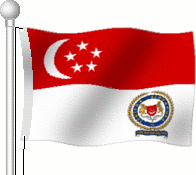 The
SAF Flag is the
national flag proper with the SAF emblem charged in the lower fly. As this
flag represents of all the SAF services, the Joint-Service or Tri-Service
flag rather than just simply a service flag is perhaps a more accurate
description of the flag. The
SAF Flag is the
national flag proper with the SAF emblem charged in the lower fly. As this
flag represents of all the SAF services, the Joint-Service or Tri-Service
flag rather than just simply a service flag is perhaps a more accurate
description of the flag.
This
flag must be flown second to the national flag at all military
installations followed by the appropriate service flag in third position.
It is to be displayed from sunrise to sunset. The proportion of the flag
is 2:3. The SAF Flag was inaugurated on SAF Day Parade of 1st July 1989.
Where
it is necessary to display all the service flags of the armed forces
together, the tri-service flag will still take precedence over the
individual service flags. The service flags of the Army, Navy, and the Air
Force, in that order, will come after the SAF Flag. This order is adopted, as it is
reflective of the chronological order whereby each service was established
in Singapore.
There
was one special occasion when the SAF Tri-Service Flag was seen hoisted
alongside the Police and Civil Defence service flags. It was during the Joint
Passing-Out Parade Ceremony for National Service recruits from the
military, police, and civil defence forces. Such an event took place in 1992
at SAF's Nee Soon Camp, commemorating 25 years of National Service in
Singapore. On a photograph from the event, the national flag, the SAF
Tri-Service flag, the Police and the Civil Defence service flags were seen
hoisted together, in that given order. The other service flags of the
armed services were not hoisted however. (See
also Section 2.5A.I, Singapore Police & Civil Defence Forces Joint
Installation)
2.1A.I - The Singapore Armed
Forces Emblem
The SAF emblem and its
symbolism from Mindef's website: "The SAF [emblem] is emblazoned on the
State Flag. The SAF emblem comprises the State Arms [but without the
scroll bearing Majulah Singapura], encircled by the inscription of the
SAF in the national language (Malay) - TENTERA SINGAPURA. This
symbolises the protection and preservation of the values of democracy,
peace, progress, justice, and equality represented in the State Arms. The
guiding principle of the SAF is reflected on the ribbon - YANG PERTAMA
DAN UTAMA (translated from Malay as "First and Foremost") signifying
victory and merit in all endeavours. The laurels ... are a symbol of
honour, glory and excellence - aims that the SAF strives
towards." Apart from the absent motto-scroll, the national achievement
of arms'
original water spurts compartment has also been replaced with palm
fronds.
While this SAF emblem is the common
and Army exclusive emblem, the Republic of Singapore Navy and the
Republic of Singapore Air Force have their own service emblems. They are
not used on the Navy and Air Force service flags but they appear on
their respective State Colour. (Refer to Page 2,
Sections 4.2B and 4.2C)
There are varying depictions of
the SAF emblem. The one appearing on the SAF Tri-Service flag as above and
the current SAF State Colour (Refer to Page 2,
Section 4.2A.i) is the most current and most used variant. It is
also used on the current Army service flag (See
Section 2.2A on this page). The one appearing on the former Army
service flag (See Section 2.2B on this page) and
the former Army Unit & Formation State Colours (Refer to Page 2,
Section 4.2A.II.a) was another variant with distinctly thick
green palm fronds. This version was to a great extent derived from the one
appearing on the Regimental Colour of the 1st Singapore Infantry
Regiment (1SIR) which defines the wreath clearly as palm leaves and is
depicted in green. The Regimental Colour of the 1SIR was the first
instance where the SAF emblem was used on a flag. The Colour was
presented to the regiment in 1961. (Refer to Page 2,
Section 4.1D)
2.1A.I.a - A Special Mention on
the SAF Military Police Command Badge
There
is one special badge in the SAF that deserves special mention, that of the SAF
Military Police Command (SAF MPC). Worn exclusively by the military
policemen on their white helmets and berets, their badge is a combination of the
emblems of the SAF and the Singapore Police Force. Their cap/helmet
badge has the elements of the SAF badge as shown above but without the
lower blue motto-scroll "Yang Pertama dan Utama". In the
place of the SAF motto-scroll is however the exact blue scroll and
ribbons from the lower half of the badge of the Singapore Police Force
(Refer to Section 2.5A of this page).
Instead
of the inscription "Polis Repablik Singapura" as per the
Police emblem, the one on the badge of the SAF MPC reads "SAF Military
Police". The badge is however not to be confused with the
Military Police Command unit insignia which is the basis of their Regimental Colour (Refer
to Page 2, Sections 4.3B.I and 4.3B.II). This unit was formerly
known as the SAF Provost Unit (SAFPU), prior to 1st September 2006.
I
find this union of emblems very symbolic and interesting. However I am
uncertain why this is so. The most probable reason I would say is
their policing duties. As the police force of the SAF, I suppose this
union was adopted. The Singapore Police Force was also considered as
part of the armed forces during Singapore's early days as a republic,
administered together with the armed services, under the then Ministry
of the Interior and Defence.
2.1B - The SAFTI Military Institute
Formation Flag
 The tri-service training institute of the SAF is known as SAFTI
Military Institute. It is the only establishment of the SAF to have
a formation flag hoisted on a pole alongside the military service flags. The flag
is made up of a
plain red field on which is charged the SAFTI M.I. insignia; a torch and a broadsword in
saltire, flanked on its left and right by green palm fronds. A blue scroll
appears beneath and is inscribed with the motto of the institute: "To Lead,
To Excel, To Overcome", in yellow text. The flag is in the proportions of
2:3. The tri-service training institute of the SAF is known as SAFTI
Military Institute. It is the only establishment of the SAF to have
a formation flag hoisted on a pole alongside the military service flags. The flag
is made up of a
plain red field on which is charged the SAFTI M.I. insignia; a torch and a broadsword in
saltire, flanked on its left and right by green palm fronds. A blue scroll
appears beneath and is inscribed with the motto of the institute: "To Lead,
To Excel, To Overcome", in yellow text. The flag is in the proportions of
2:3.
The SAFTI M.I. formation flag is flown last
alongside the service flags of the three services in this order: the national
flag, the SAF flag, the Army, Navy, and Air Force service flags and followed by the SAFTI
M.I. flag. SAFTI
M.I. is a special establishment as it is the "Home of the Officer
Corps". This is manifested by the fact that they are the only
unit/formation entitled to a unit/formation State Colour at present (Refer
to Page 2, Section 4.2A.II.c). The current Regimental Colour of
SAFTI M.I. is similar in design to the formation flag (Refer to Page 2,
Sections
4.3B.I & 4.3B.II).
Multi-organisation
installations are interesting cases where one can observe how the flags of
various organisations are arranged when they come together. SAFTI M.I. as
can be seen is one case where the military services are concerned. Also of
considerable comparative interest is the home services equivalent, the
Home Team Academy, a case which will be noted in section 2.5D.
[Return
to Directory] |
|
2.2 -
Singapore Army |
|
The basic component any military
is the land forces. The Singapore Army thus provides the landward defence
of Singapore. The Singapore Army comprises various formations and units
notably the Infantry, Commandos, Guards, Armour, Artillery, Engineers,
Signals, and Logistics.
Although several land units
existed in colonial Singapore, the use of a distinctive service flag for
the land units then was very unlikely. This is because the British Army
did not really have a distinctive service flag, and units and formations would prefer only to display the Union
Flag when necessary. However, the use of unit-based flags (today the
ceremonial colours, guidons, and standards) by the Army formations is more
profound and complex as compared to the other military services as will be observed
on Page 2.
2.2A - The Singapore Army Service
Flag
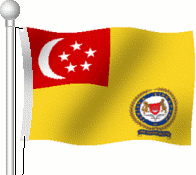 The current Army
service flag has a yellow field with the canton (1st quarter of a flag's
layout) from the canton of the national flag, and the SAF emblem charged in
the lower fly (4th quarter of a flag's layout). The current Army
service flag has a yellow field with the canton (1st quarter of a flag's
layout) from the canton of the national flag, and the SAF emblem charged in
the lower fly (4th quarter of a flag's layout).
The service flag shown here is the current version. The former service flag (as presented below) was inaugurated on SAF Day of
1980. It was formally approved in December 1979 at the Army Conference.
The flag must be flown in third position and preceded by both the national
flag and the SAF Flag at army installations. It is displayed from sunrise to sunset at
the various army installations and the proportion of the service
flag is 2:3.
The yellow field was chosen to differentiate the army from the other
services as yellow is the colour of the field of Singapore's first very
own Regimental Colour, that of the 1st Singapore
Infantry Regiment (Refer to Page 2, Sections 4.1D or 4.3B.I)
2.2B - Former Service
Flag
 The SAF emblem used on the current service
flag is now equivalent to the
SAF
emblem on the SAF Joint-Service flag as shown previously in 2.1. The SAF emblem that
appears on the former Army Flag is slightly different from the one that
appears on the SAF Joint-Service flag and current Army service
flag. Notably, the wreath is green & thicker
(likely palm fronds) and the emblem features an additional red
ribbon. The SAF emblem used on the current service
flag is now equivalent to the
SAF
emblem on the SAF Joint-Service flag as shown previously in 2.1. The SAF emblem that
appears on the former Army Flag is slightly different from the one that
appears on the SAF Joint-Service flag and current Army service
flag. Notably, the wreath is green & thicker
(likely palm fronds) and the emblem features an additional red
ribbon.
This former emblem
version is highly likely to have been derived from the badge appearing on
the Singapore Infantry Regiment's Regimental Colours as was detailed in 2.1A.I
earlier. This flag
was often shown in the earlier years' Recruit's Handbook issued to newly enlisted
conscripts (for National Service).
The history
of the SAF emblem traces back to 1961, when the 1st Singapore Infantry
Regiment held a ceremony for the change in their beret badge. Singapore
was a self-governing British colony then. (Refer to Page 2, Section 4.1D)
[Return
to Directory] |
|
2.3 -
Republic of Singapore Navy |
|
The maritime
defence of Singapore is undertaken by the Republic of Singapore Navy
(RSN). They were formerly the Singapore Naval Volunteer Force
(1966-1967), Sea Defence Command (1967-1968), Maritime Command (1968-1975),
and the Republic of Singapore Navy since 1975. However, their
history can be linked to the colonial period as will be discussed in
Section 2.3D.
2.3A - The Republic of
Singapore Navy Service Flag
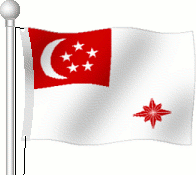 The RSN
service flag is white and the red canton is from the
canton of the national flag. The lower fly is charged with a red stylised
8-pointed cardinal device (termed 'Mariner's Compass'). This
flag is derived from the Singapore Naval Ensign. Ensigns are a special
category of flags flown at sea for status differentiation - merchant or
civil vessels, military service vessels or non-military government service
vessels. The RSN
service flag is white and the red canton is from the
canton of the national flag. The lower fly is charged with a red stylised
8-pointed cardinal device (termed 'Mariner's Compass'). This
flag is derived from the Singapore Naval Ensign. Ensigns are a special
category of flags flown at sea for status differentiation - merchant or
civil vessels, military service vessels or non-military government service
vessels.
The RSN Naval Ensign is also
flown at shore establishments, like that practiced by the British Royal
Navy with their naval ensign. However, it is a requirement that the RSN Naval Ensign be flown with
the Singapore national flag and the SAF Tri-Service flag when hoisted
ashore. While the legislative papers gave the RSN Naval Ensign official
proportions of 1:2, it is more common a practice to fly flags of similar
proportions together. Thus when flown ashore as a service flag, the ensign
takes the proportion of 2:3. Therefore technically, as a
differentiation between the ensign and service flag, the height to length
proportion of the naval ensign should be 1:2, while the service flag is
2:3.
The proper naval
ensign was granted to the naval forces on 5th May 1967, at Telok Ayer
Basin where the previously used blue State Ensign was ceremonially
lowered. Republic of Singapore Navy Day is thus celebrated on 5th May to commemorate their
ensign's official launch. The service flag besides being
similar to the naval ensign, also
served as the design for the Navy's Service-Regimental Colour prior to 1996
(Refer to Page 2, Section 4.3A.II.b). In
effect, this design once served as a service flag, ceremonial flag and as
an ensign.
2.3B - The Republic
of Singapore Navy Jack, Ensign, & Commission Pennant
The three
basic flags flown by navies onboard naval vessels are the naval ensign,
the commission or masthead pennant and the naval jack. In countries with
the practice of using rank flags, the rank flag will replace the commission
pennant where and when necessary.
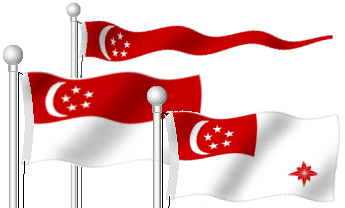 2.3B.I - The RSN Naval Jack 2.3B.I - The RSN Naval Jack
The Naval
Jack (leftmost) used by the Singapore Navy is the national flag. Jacks
are flags flown on the bow (front end) of navy vessels, also indicating
nationality, usually only while in port. It is raised at 0800hrs and
lowered at sunset.
According to
a reply by the Navy, when an enquiry was made on the Naval
Jack, it was said that, "...based on our navy book (1997 edition),
it's 1:2." However, from photographs, it seemed to be more in the
proportion of 2:3.
2.3B.II - The RSN Naval Ensign
(The Singapore Naval Force Ensign)
The naval ensign or war ensign
(rightmost) is exclusively flown by military service vessels under the
command of the navy, for
differentiation between non-military government service vessels and
civilian vessels at sea. It is possible that other military services
operate their own sea-going vessels and have their own ensign like that
once practiced by the British Army but which is no longer the case. This
has not been the case in Singapore. From 1965 to 1967, the navy flew the Singapore
State Marine Ensign (Refer to Section 2.5C.I on this
page).
The ensign is officially called
the "Singapore Naval Force Ensign" in its legislation, which was
officially presented to Parliament by the Minister of Defence on 27th
February 1967, titled under "Misc. 1 of 1967". It has the same
construction sheet as the blue State Marine Ensign. The legislative
papers gave the naval ensign a 1:2 proportion. However, those flown by
the RSN on their vessels these days are in the proportions of 2:3,
similar to the RSN service flag. The naval ensign is flown either near the mast or at the stern (rear) of a vessel,
never on the bow.
2.3B.III -
The RSN Commission Pennant
Commission pennants are long streamer-like triangular flags flown above the
ensign
on the mast of a military vessel. Like all navies, the RSN also has commission
pennants. It is red with the white crescent and 5 stars
emblem charged at the hoist (extreme left) of the pennant. The pennant
indicates a vessel's commissioned status. It will be presented on the
vessel's commissioning ceremony. Once the vessel is decommissioned, the
commission pennant will be lowered for the last time as part of the
ceremonies. Traditionally, a paying-off pennant is used for
decommissioning ceremonies. Paying-off pennants are basically the
Commission Pennants but made in a proportion reflecting the length of
service of the vessel concerned. The longer the service, the longer the
pennant will be. Many of such decommissioning pennants are available for
viewing at the Navy Museum.
2.3C -
Distinguishing Flags
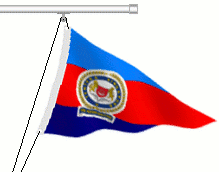 Unlike other countries, for example the United
States and the United Kingdom, there is no practice of using rank flags
for the Generals and Admirals (Flag Officers) of the Singapore Army, Navy, and Air Force. Unlike other countries, for example the United
States and the United Kingdom, there is no practice of using rank flags
for the Generals and Admirals (Flag Officers) of the Singapore Army, Navy, and Air Force.
There
are however the Distinguishing Flags of the
Chief of Defence Force and Chief of Navy that are flown on naval vessels and
bases, particularly at the outboard halyard of the starboard yardarm when
these officers are in presence.  The
precedence of flags on a flag pole with a yardarm and gaff is as follow:
the gaff, the peak, the port yardarm (the left arm), and the starboard
yardarm (the right arm). For poles with yardarm but without a gaff, the
peak is the primary position, followed by the port then starboard
yardarms. These pennants are thus flown at the junior-most position. The
precedence of flags on a flag pole with a yardarm and gaff is as follow:
the gaff, the peak, the port yardarm (the left arm), and the starboard
yardarm (the right arm). For poles with yardarm but without a gaff, the
peak is the primary position, followed by the port then starboard
yardarms. These pennants are thus flown at the junior-most position. The
Chief of Defence Force pennant as shown on the left comprises a horizontal
tricolour of light blue, red and dark blue representing the three
component armed services and the SAF emblem at the centre. SAF Military Heritage Branch described the
Chief of Navy pennant as a blue triangular flag, charged with the RSN
emblem as shown on the right.
A
"Commander's Pennant" was reported to be used from 1970 to 1975
and is displayed at the
Navy Museum. The pennant was similarly blue, with a white fouled anchor,
and the initials "RSN" at the fly tip. In its earlier years, the Navy was
headed by a Commander.
2.3D - The Naval Flags
of the Pre-Independence Naval Forces, 1819 – 1965
(With the assistance of FOTWer, David
Prothero)
2.3D.I
– The Royal
Navy
 Singapore was, from 1819 to 1963, under the
administration of the United Kingdom. During
that period, the colonial administrators handled Singapore’s maritime
defence matters. Upon independence in 1965, the British retained their
military presence in Singapore until full withdrawal in 1971. Singapore was, from 1819 to 1963, under the
administration of the United Kingdom. During
that period, the colonial administrators handled Singapore’s maritime
defence matters. Upon independence in 1965, the British retained their
military presence in Singapore until full withdrawal in 1971.
The British
Royal Navy's naval jack, ensign, and the masthead pennant (commission pennant) is to be flown by all war
vessels of the Royal Navy.
The
colonial
Royal Naval Volunteer Reserves of the empire were initially not entitled to wear
the Royal Navy's White Ensign, except in the situations where they are deployed in
service of the empire outside of their territorial waters, as directed
under the Colonial Defence Act of 1931 or as authorised by the Admiralty
to do so.
The Naval
Jack (leftmost) of the Royal Navy is the Union Jack (the proper term
to be used when the British Royal Union Flag is used in such a manner).
The Jack is
generally restricted to be flown while the vessel is in
port. As a naval jack, it takes the proportion of 1:2. The Union Flag
when flown from the mast is the Rank Flag of the Admiral of the Fleet but in the
proportions of 2:3.
The famous
White Ensign (rightmost) has a white field with the red St
George's cross
throughout. The British Union Flag makes up the
canton. This naval ensign besides being flown by the Royal Navy was also
flown by colonial navies of the British Empire in later periods. The White
Ensign is also flown ashore, at the establishments of the Royal Navy,
such as HM Naval Bases.
The White
Masthead Pennant (top-rear) of the Royal Navy is triangular and
white with the St George's cross in the hoist. The British blue
masthead pennant is similar to the white masthead pennant, in that the
red St George's cross on white remains at the hoist, but the rest of
the pennant is blue.
The
English Navy first practiced the use of differentiating ensigns.
There were three squadrons each flying its distinctive
ensign differentiated by colour. There was the centre squadron,
commanded by the Admiral of the Fleet, which flew the red ensign, there
was the van squadron, commanded by the Vice-Admiral, which flew the blue
ensign and there was the rear squadron, commanded by the Rear-Admiral,
which flew the White Ensign. In 1864, the divisions of squadrons were
ceased and the White Ensign was retained by the British Navy as their naval
ensign, and its use and influence has since spread across the globe with
the expansion of the British Empire. Besides the
above flags, the Royal Navy also practices the use of Rank Flags for the
Commodores and Flag Rank Officers (Admiral ranks). See
FOTW: UK
Royal Navy Rank Flags for more information. The
Royal Navy is considered the senior service amongst the British armed
forces. The Army and Air Force are the next in precedence. At the
Queen's Birthday Parades in colonial Singapore, the White Ensign took
precedence, followed by the Union Flag representing the Army, followed
by the Royal Air Force Ensign, and the local Police service flag (see
the Police service flags below in part 2.5B.II).
(PICAS Negatives Nos. A0668/24/13; A1653/02; T2001,31650)
2.3D.II – The Straits
Settlements Royal Naval Volunteer Reserve, 1934 – 1947
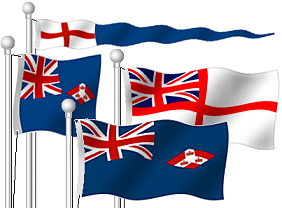 The Straits Settlements NVR was established in
April 1934 with the main division in the settlement of Singapore. In
October 1938, the Penang branch was established. The Force was initially
not 'Royal' as it was not under the jurisdiction of the British
Admiralty. 'Royal' was only added from 1936 onwards, when it began to be
listed by the Admiralty. The Straits Settlements NVR was established in
April 1934 with the main division in the settlement of Singapore. In
October 1938, the Penang branch was established. The Force was initially
not 'Royal' as it was not under the jurisdiction of the British
Admiralty. 'Royal' was only added from 1936 onwards, when it began to be
listed by the Admiralty.
The
unit was renamed as the Malayan RNVR for the duration of the war
with effect from October 1941 by the Emergency Powers (Defence) Act of
1939.
Singapore
fell to the Japanese in 1942 and henceforth, the unit ceased to exist
(The Malayan RNVR was nonetheless regarded as mobilised and serving with the Royal
Navy from 1942 to 1947). As the renaming of the Force was done by
the Emergency Powers (Defence) Act of 1939 and not the Governor in
Council Ordinance, the Malayan RNVR should have reverted to its original
name, the Straits Settlements RNVR, at the end of the war in 1945. This
unit was nonetheless officially disbanded on 11th March 1947. The force
was re-formed in 1948 as the Malayan RNVR.
•
Jack *: Blue Jack defaced with the Badge of the Colony of the
Straits Settlements
• Ensigns:
- Colony of the Straits Settlements Blue
Ensign (1934 - 1940)
- UK Royal Navy White Ensign (for World War
Two: 1940 - 1942)
• Masthead
Pennant: the Blue Masthead Pennant
* The shape of
the Jack used seemed to have alternated between square and rectangular. The
leftmost of the four naval flags above is the square version of the jack, as was seen on a photograph of one of the vessels of the RNVR,
HMS Peningat. The vessel was also wearing the White Ensign in the
same photograph (by Admiralty's wartime instructions). Vessels of the
RNVR are at other times to wear their own colonial blue ensign, as the
ensign at the stern and as the jack at the bow.
2.3D.III – The Malayan Royal Naval Volunteer Reserve,
1948 – 1963
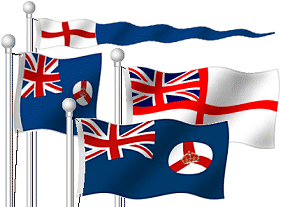 In July
1948, the Malayan RNVR was re-formed in the Colony of
Singapore. The Malayan RNVR was later reconstituted as a joint force
comprising of the Singapore Division and the Federation Division, by an
Ordinance passed in Singapore in 1952. In July
1948, the Malayan RNVR was re-formed in the Colony of
Singapore. The Malayan RNVR was later reconstituted as a joint force
comprising of the Singapore Division and the Federation Division, by an
Ordinance passed in Singapore in 1952.
The Federation Division was listed to
1957, the year the Federation of Malaya became independent.
Singapore Division lasted until 1963 when it was handed
over to the newly formed Malaysian federation and became the Singapore
Volunteer Force, under the command of the Royal Malaysian
Navy.
•
Jack *: Blue
jack defaced with the Singapore colonial badge
•
Ensigns:
- Colony of Singapore Blue Ensign (1948 - 1952)
-
** UK Royal Navy White Ensign (1952 - 1963)
•
Masthead
Pennant: the blue masthead pennant
* The Jack
shown above is the square variant, although rectangular variants have
been documented. The Queen's Regulations and Admiralty Instructions of
1956 required that all RNVR vessels of the British Empire were to
specifically wear square Naval Jacks.
** Issues with regard to the use of white or blue ensigns by the colonial naval reserves in the British Empire arose after the war. It was settled that
the White Ensign was to be flown by the colonial naval reserves
after 1952. The Hong Kong RNVR and Mauritius RNVR flew it as well.
The Singapore Marine
Police also flew at the stern the colony's blue ensign with the circular badge on its vessels
but until 1960 when the current Singapore State Marine Ensign was
introduced. (To be detailed in section 2.5C to
follow.)
2.3D.IV – The Malayan Naval Force, 1948 – 1952 / The
Royal Malayan Navy, 1952 – 1958
1948 - 1952
: The Colonial Government of British Singapore raised and financed a
regular naval force in 1948 to be known as the Malayan Naval
Force. The Singapore Legislative Council passed the ordinance on
24th December 1948. The pioneering personnel were from the British Royal
Navy's Malay Section (1939 - 1947) that was raised for the Second World
War. Although the Malayan Naval Force was raised and financed by
Singapore, the navy was nonetheless named after Malaya (for it was a
Pan-Malayan force) and it recruited personnel from throughout Malaya and
Singapore.
•
Jack, Ensign, & Masthead Pennant: Union Jack at the
bow, blue pennant at the mast, and possibly the blue ensign with the colony of
Singapore badge at the stern (The ensign for Malayan Naval Force
vessels is unconfirmed and could have very well been the White Ensign
rather)
1952 - 1958
: On 25th August 1952, the Malayan Naval Force was conferred ‘Royal’
status by HM Queen Elizabeth II, thus becoming the Royal Malayan
Navy. The vessels of the Royal Malayan Navy were thus privileged
to fly the Royal Navy's White Ensign and her vessels were prefixed with
/ referred to as 'Her Majesty's Malayan Ship' or 'HMMS'. The Royal Malayan
Navy of 1952 - 1958 thus flew as the:
•
Jack: Blue
jack defaced with the Singapore colonial badge
•
Ensign: UK Royal Navy White Ensign (flown at Royal
Malayan Navy Barracks as well)
•
Masthead
Pennant: the blue masthead pennant
2.3D.V – The Royal
Malayan Navy (Tentera Laut Di-Raja Malaya), 1958 –
1963
The Federation of Malaya was granted independence
from the United Kingdom within the Commonwealth in August 1957. The
control of the Royal Malayan Navy was handed over from the colonial
government of British Singapore to the newly independent government of
the Federation of Malaya the following year on 1st July 1958.
• Jack:
Federation of Malaya national flag of 1957 - 1963 (11-pointed star and
11-stripes)
• Ensign: Royal Malayan Navy Ensign (White field, Federation flag as the canton,
red cross throughout)
•
Masthead Pennant:
Royal Malayan Navy Blue Masthead Pennant (Gold crescent and 11-pointed
star all on blue)
With the handing over of the regular navy, British
Singapore had one local naval force left, the Singapore Division of the
Malayan RNVR, for the years 1958 to 1963. The Royal Navy was the other
force present in Singapore. The Royal Malayan Navy however was still
responsible for maritime defence matters of the Malay peninsula and
Singapore together with the Royal Navy which still maintained its
presence in Singapore.
2.3D.VI
– The Royal
Malaysian Navy (Tentera Laut Di-Raja Malaysia), 1963 – 1965
–
Present
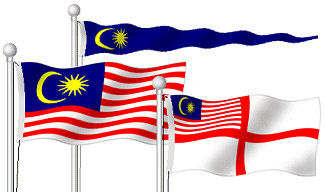 The federation of Malaysia was formed in 1963 (comprising of
the Federation of Malaya, Singapore, Sabah, & Sarawak). The Royal
Malayan Navy was thus renamed the Royal Malaysian Navy or in Malay, Tentera Laut
Di-Raja Malaysia
(TLDM). The federation of Malaysia was formed in 1963 (comprising of
the Federation of Malaya, Singapore, Sabah, & Sarawak). The Royal
Malayan Navy was thus renamed the Royal Malaysian Navy or in Malay, Tentera Laut
Di-Raja Malaysia
(TLDM).
As matters concerning defence was a federal prerogative, the
Singapore Division of the Malayan RNVR was handed over to the government
of the federation of Malaysia in 1963 and was renamed the Singapore
Volunteer Force. It was a volunteer unit under the command of the TLDM.
•
Jack: Federation of
Malaysia national flag of 1963 (leftmost)
•
Ensigns:
-
1963 to 1968: TLDM ensign, a white field with a red
cross throughout and featuring the Federation flag of 1963 in the
canton (as shown rightmost here)
-
1968 to Present: TLDM ensign, a white field featuring
the Federation flag of 1963 in the canton and a blue navy emblem,
comprising of two keris in saltire and a naval anchor, in
the lower fly
•
Masthead Pennant:
Blue with the gold crescent and gold 14-pointed star at the hoist. (Top-rear)
Singapore
seceded from the Federation to become a sovereign republic in 1965. The
Singapore Volunteer Force was thus detached from the TLDM. Upon
independence in 1965, the use of the Malaysian naval flags by Singapore
vessels ceased. The Singapore Volunteer Force became the Singapore Naval
Volunteer Force. The
force adopted the blue Singapore State Ensign (2.5C.I)
temporarily until
Singapore's own white Naval Ensign was introduced two years later in
1967.
(Information based considerably
from the UK Public Record Office documents:
ADM 1/16053, ADM 1/19766,
ADM 1/26825,
ADM 1/27041,
Colony of Singapore & State of Singapore Annual
Reports 1946 - 1963,
Navy Lists 1936 - 1963)
[Return
to Directory] |
|
2.4 -
Republic of Singapore Air Force |
|
The
maintenance of the republic's aerial defence is the responsibility of the Republic of
Singapore Air Force (RSAF). From 1968 to 1975, they were known as the
Singapore Air Defence Command (SADC).
2.4A - The Republic of
Singapore Air Force Service Flag
 The current RSAF
service flag is light blue with the
canton of the national flag for its canton, and the RSAF roundel charged
in the lower fly. The roundel of the RSAF shows a red lion-head symbol
with five distinct mane partings. This current version was adopted in
1990. The current RSAF
service flag is light blue with the
canton of the national flag for its canton, and the RSAF roundel charged
in the lower fly. The roundel of the RSAF shows a red lion-head symbol
with five distinct mane partings. This current version was adopted in
1990.
The lion-head
symbol accordingly, is a representation of courage, strength, and resolve
and its five manes have a meaning equivalent to the five stars of the national
flag, i.e., peace, equality, justice, prosperity, and progress. This
roundel was also once used on the RSAF Service-Regimental Colours (Refer to Page 2, Section 4.3A.III.b).
The flag, as
per the Army and Navy service flags, must be flown in third position and
preceded by both the national flag and SAF flag. It is displayed from
sunrise to sunset at their installations. The proportion of the flag is
2:3.
Light blue is
the colour most commonly used to represent air forces worldwide. It was also in most probability the
influence from the colonial administrators, for the UK was the first to
introduce the air force ensign to Singapore.
2.4B - The Former Service Flags (1968*
– 1973)
and (1973
– 1990)
  The RSAF had two former
service flags prior to 1990, which respectively followed the histories of
the air force roundels. The RSAF had two former
service flags prior to 1990, which respectively followed the histories of
the air force roundels.
The first (SADC) roundel was a circle divided concentrically into 3 (shown on the
extreme left). It was simply red-white-red and was used from 1968* to 1973
on the very first RSAF service flag and their aircrafts during that
period.
The RSAF roundel was changed in
1973, to a design of a red and white yin-yang symbol with stylized red and
white rays issuant from the top and bottom of the yin-yang symbol. This
roundel was used by the RSAF aircrafts and on their second service flag from 1973-1990.
* The first roundel was in use
since 1968. However, it is uncertain if the flag was adopted exactly in
that year. The flag however did exist it seems and one is now displayed at
the RSAF Museum together with the 1973 to 1990 version.
2.4C - Colony of Singapore & the Royal Air
Force
 As with the case of the Navy, the British set up their Royal Air Force
(RAF) stations in the colony of Singapore. And as such, they flew their
air force flags in Singapore, notably the RAF Ensign. It was this
RAF ensign that obviously influenced the design of Singapore's air force service flag
and indeed many others around the world too. As with the case of the Navy, the British set up their Royal Air Force
(RAF) stations in the colony of Singapore. And as such, they flew their
air force flags in Singapore, notably the RAF Ensign. It was this
RAF ensign that obviously influenced the design of Singapore's air force service flag
and indeed many others around the world too.
The RAF ensign is light blue, featured the Union Flag in the canton and
the RAF roundel in the centre-fly (as opposed to lower-fly on the RSAF
service flag). The RAF roundel is a circle concentrically divided into
three parts comprising of blue-white-red (outermost to innermost)
portions. The RAF
ensign is in the proportions of 1:2, like the Union Flag itself. The term
"Ensign" while mostly associated with the maritime flags
(State-Civil-Naval Ensigns) can also be used to refer to flags in general
as can be observed here.
The RAF has chosen to refer to their service flag as the RAF Ensign since
its proposed days. The RAF Ensign was officially adopted in May 1921 after
some strong opposition by the Royal Navy. For a more complete and detailed
history of the RAF Ensign, see the FOTW
: UK Royal Air Force page for more information.
In line with the established order of precedence of the British armed
forces, the RAF Ensign is flown third when flown together with the flags
of the other services. The services flags were flown together at the
Queen's Birthday Parades in colonial Singapore for instance. It is
preceded by the Royal Navy's White Ensign and the Union Flag representing
the Army elements. It is then followed by the service flag of the colonial Singapore
Police Force. Photograph references listed under the Royal Navy entry
above. (See section 2.3D.I above)
The British maintained the Air Bases in Singapore even
after independence up until 1971, when they withdrew their troops from
Singapore. The Air Bases were then handed over to the Singapore Air
Defence Command. There was no mention (as far as I am aware) of the RAF
handing over the Air Bases to the Malaysian Government of 1963 to 1965. RAF
stations in Singapore included RAF Tengah, RAF Changi (also Headquarters
RAF Far East), and RAF Seletar. There was also the temporary
existence of the Malayan Auxiliary Air Force in the region. Singapore was
part of the RAF's geographical command called the Far East Air Force. (Refer to
Page 2, Section 4.1E)
[Return
to Directory] |
|
2.5 -
Singapore Police Force |
|
The Singapore
Police Force (SPF) is responsible for the general security of the State,
which includes the maintenance of law and order, the preservation of the
public peace, the prevention and detection of crime, and apprehension of
offenders. This is inclusive of our maritime security, undertaken by the
Police Coast Guard Command.
2.5A - The Singapore
Police Force Service Flag
 The
Police service flag is in their corporate colours of
navy blue, with the SPF emblem rendered in white in the centre. The actual
coloured Police emblem has the red State shield within the blue and white
garlands of paddy-sheaths held together with blue ribbons. A blue scroll
appears below, with the name of the force in the national language
(Malay), "Polis Repablik Singapura" translated as Republic of Singapore
Police. Apparently, another variant of the
Police service flag
has the shield white and the stars in blue. Both
versions are official designs. The
Police service flag is in their corporate colours of
navy blue, with the SPF emblem rendered in white in the centre. The actual
coloured Police emblem has the red State shield within the blue and white
garlands of paddy-sheaths held together with blue ribbons. A blue scroll
appears below, with the name of the force in the national language
(Malay), "Polis Repablik Singapura" translated as Republic of Singapore
Police. Apparently, another variant of the
Police service flag
has the shield white and the stars in blue. Both
versions are official designs.
The flag is
flown in second position to the national flag. It is displayed from
sunrise to sunset at their installations. The proportion of the flag is
2:3. There are unit flags in the SPF, although their use in public is
rather uncommon. The idea of a police badge placed on a plain blue
field for a service flag was in use since at least the post-war period.
As mentioned under Section 2.1A.I.a earlier, part of the scroll and
ribbons also appear on the badge of the SAF Military Police Command. The
Central Narcotics Bureau, a separate department under the
Home Affairs ministry, also
incorporates elements of the police badge in the CNB service emblem, in
particular the national shield and wreath, but not the scroll. A
1996 publication of the CNB states that "[the police emblem] indicates the
close cooperation between CNB and the police in keeping Singapore free
from drugs". CNB's emblem also features a silver starburst base on
which the shield and wreath appears at the centre (Section
2.8C). The Customs and
Excise Department also shared a service emblem template with the police
force prior to 1968. This will be noted in the former police emblems
section to follow and in the entry on Singapore Customs in Section
2.8A.
2.5A.I –
Order of Flags at Multi-Organisation Premises
In the
entry under the Singapore Armed Forces Tri-Service flag in 2.1A
earlier, it was observed that the police flag was hoisted together with
the SAF flag and the Singapore Civil Defence Force flag for a special
national event. The hoisting of flags of various organisations together did not end
there and today there are several cases where the police flag are hoisted alongside the flags of other organisations. The following cases
notes the places where this is observable and the flag order policy as
can be observed at these places. 2.5A.Ia.
Singapore Police Force and Singapore Civil Defence Force Joint
Installation
A unit of
the Singapore Police Force shares premises with two units of the Singapore
Civil Defence Force (SCDF) at Queensway since 2005 (SPF's Queenstown
Neighbourhood Police Centre and SCDF's Headquarters 1st Civil Defence
Division & Alexandra Fire Station). There, the following order of flag
display is observed at the main flagpoles area: the national flag is followed
by the SCDF service flag, the SPF service flag and the SCDF HQ 1st CD
Division unit flag. This is in contrast to the situation mentioned in
2.1A where during the joint commemoration of
the 25th year of national service in Singapore, the Police service flag took precedence
over the Civil Defence service flag. The site for the joint installation
at Queensway was originally the site of
Alexandra Fire Station. The flags of the SCDF is presented in section
2.7 to follow. 2.5A.Ib.
The Home Team Academy The
Home Team Academy is also a special place where the police flag is flown
together with the flags of other Home Team services. The flag order is
different at this location where the Police and Civil Defence is
concerned. The case of the Home Team Academy is noted in further
detail in section 2.5D to follow. 2.5A.Ic.
Singapore Police Force Units at Civic Centres The
majority of police units/centres in Singapore operate within their own
designated premises, thus the normal flag display order is observed -
the national flag followed by the police service flag. In addition to
the special cases with the Civil Defence Force and the Home Team Academy
above, there are several neighbourhood police centres that are
co-located with other civic organisations as well. One example is the
Sengkang Community Hub, where the Sengkang Neighbourhood Police Centre
is co-located with the Sengkang Community Club administered by the
People's Association (PA), and Singhealth's Sengkang Polyclinic amongst
several others. Another example is the Bukit Batok Neighbourhood Police
Centre which is co-located with PA's Bukit Batok East Community Club.
The police service flag is hoisted alongside the flags of these other
organisations at these places. The observed order thus far is that the
national flag will as per normal take precedence and the police service
flag will be hoisted on the last pole, with the other organisations'
flags taking the remaining positions in between. It is likely, though
unconfirmed, that alphabetical order is used as a basis for the ordering
of flags at these places.
2.5B - Former
Police Emblems & Service Flags
The
police emblems throughout history were generally similar as it is today.
The scrolls were depicted in different forms and arrangement in
their course of history. Within the wreath where the State shield sits
today, the emblem of the prevailing period of time was used.
2.5B.I – Colony
of the Straits Settlements (Straits Settlements Police)
The
Singapore Police Force had its roots as the Straits Settlements Police.
Within the wreath was the lozenge badge of the British
Straits Settlements. Their scroll bore the inscription "Straits
Settlements Police". There does not seem to be a service flag then.
2.5B.II – Crown
Colony of Singapore (Singapore Police Force)
 In 1946,
Singapore's status became that of a crown colony by itself with the
reorganisation of the British possessions in Malaya which involved the
dissolving of the Straits Settlements. The badge of the
Colony of Singapore now featured a single crown (instead of three), on a
red pall reversed (instead of a white pall reversed), on a
white disc (instead of a red lozenge). The
scroll on the police badge then bore "Singapore Police Force". The
emblem of the Police still retained the lozenge despite the change
of the ensign badge defacement from a lozenge to a disc. The badge appeared on the front covers of their quarterly publications
(Singapore
Police Magazine) up to the 1959 September issue. In 1953,
HM
Queen Elizabeth II ordered the change of crown design to all emblems,
badges, and flags throughout the British Empire, from the previously used
Imperial/Tudor Crown to the St Edward's crown. New flags and badges
manufactured from
that year onwards would have featured the St Edward's crown rather than
the Imperial ones. In 1946,
Singapore's status became that of a crown colony by itself with the
reorganisation of the British possessions in Malaya which involved the
dissolving of the Straits Settlements. The badge of the
Colony of Singapore now featured a single crown (instead of three), on a
red pall reversed (instead of a white pall reversed), on a
white disc (instead of a red lozenge). The
scroll on the police badge then bore "Singapore Police Force". The
emblem of the Police still retained the lozenge despite the change
of the ensign badge defacement from a lozenge to a disc. The badge appeared on the front covers of their quarterly publications
(Singapore
Police Magazine) up to the 1959 September issue. In 1953,
HM
Queen Elizabeth II ordered the change of crown design to all emblems,
badges, and flags throughout the British Empire, from the previously used
Imperial/Tudor Crown to the St Edward's crown. New flags and badges
manufactured from
that year onwards would have featured the St Edward's crown rather than
the Imperial ones.
Photographs
such as those taken at the Police Academy dated 1951 and at the Queen's
Birthday Parades of the late 1950s confirms that the police had a service flag that comprised a plain field, most likely
blue, with the police service emblem of that period at the centre. The
photographs were in monochrome and the colours used to make the flag
here have been assumed. The badge as depicted on the flag seemed to have
differed slightly from the ones used elsewhere, such as with regard to the
arrangement of the title-scroll. At the monarch's birthday
parades, the forces' flags were displayed in the following order: the
Royal Navy's White Ensign, the Union Flag representing the Army, the
Royal Air Force Ensign, and the Police service flag. Queen's Birthday
Parades photograph
references listed under the Royal Navy entry above. (See
section 2.3D.I above)
2.5B.III –
Self-Governing Colony of Singapore / State of Singapore (Polis Negara
Singapura)
 In 1959,
Singapore attained self-government status and in December of the year,
also introduced the new State Arms. This affected the Police badge and
it henceforth featured for the first time ever, the shield as appearing
on the present national arms. The scroll however bore the inscription in
Malay, Polis Negara Singapura, generally translated as
"State of Singapore Police". "Negara" generally translates to
"nation-state" in English. The new
Police emblem began to appear on the covers of their quarterly
publications (Singapore Police Magazine) since the December 1959 issue.
The badge was placed on a blue field to make the service flag of the
police for that
period. Like the previous police flag, there seems to be different
arrangement of the title-scroll for different uses of the service badge. In 1959,
Singapore attained self-government status and in December of the year,
also introduced the new State Arms. This affected the Police badge and
it henceforth featured for the first time ever, the shield as appearing
on the present national arms. The scroll however bore the inscription in
Malay, Polis Negara Singapura, generally translated as
"State of Singapore Police". "Negara" generally translates to
"nation-state" in English. The new
Police emblem began to appear on the covers of their quarterly
publications (Singapore Police Magazine) since the December 1959 issue.
The badge was placed on a blue field to make the service flag of the
police for that
period. Like the previous police flag, there seems to be different
arrangement of the title-scroll for different uses of the service badge.
The badge with certain alterations was also used by the
Singapore Customs & Excise Department with the wreath rendered in
yellow instead of green, and the scroll bearing "Singapore Customs
Excise". (See Section 2.8A on this page)
The Polis
Negara Singapura service flag should have been used from 1959 - 1963.
The service flag then was in the proportions of 1:2. The service
flag was reinstated after the separation of Malaysia and
Singapore. It is uncertain exactly when the Polis Negara Singapura service flag gave way to the present
Polis Repablik Singapura
service flag.
Photographs
of this service flag were in monochrome, thus the colours used here
have been assumed. See National Archives, Negative Numbers: B0146/07/23
(dated 19th January 1963) and 2702/02/07A (dated 22nd July 1966).
2.5B.IV –
Singapore in the Malaysian Federation (Polis Di-Raja Malaysia)
 In September
1963, Singapore attained independence from the United Kingdom as a
component state
within the federation of Malaysia. The police
forces of Malaya, Singapore, Sabah, and Sarawak were thus integrated to
become the new Polis Di-Raja Malaysia (Royal Malaysia Police). As
such, the Royal Malaysian Police badge (1963 - 1965) was used in
Singapore and on the Police service flag. In September
1963, Singapore attained independence from the United Kingdom as a
component state
within the federation of Malaysia. The police
forces of Malaya, Singapore, Sabah, and Sarawak were thus integrated to
become the new Polis Di-Raja Malaysia (Royal Malaysia Police). As
such, the Royal Malaysian Police badge (1963 - 1965) was used in
Singapore and on the Police service flag.
The Polis
Negara Singapura service flag was lowered and replaced with the new
Polis Di-Raja Malaysia service flag, at a ceremony held at the Police
Headquarters at Pearl's Hill on 17th September 1963. The Royal Malaysian
Police service flag as used in Singapore from 1963 - 1965 was in the proportions of 1:2 and
had the
Royal Malaysia Police emblem in white charged at the centre.
The emblem
of 1963 to 1965 was based heavily on that of the previous Royal
Federation of Malaya Police (Polis Di-Raja Persekutuan). Formerly, there
were two traditional Malay daggers (the Keris) in saltire. The Malay
dagger represents the Malayan component. Upon the integration,
one of the daggers was replaced with a traditional native Borneo machete
(Parang Elang / Kelawang) to represent the Malaysian Borneo components.
Additionally, a lion's head was charged in the centre to represent
Singapore. These were garlanded with paddy stalks wreath and
surmounted with the Malaysian crown. The scroll reads "Polis Di-Raja
Malaysia". The service flag in use today by the Royal
Malaysia Police is similar (plain blue field with the service emblem
at the centre) but the lion's head has since been replaced with a tiger's
head. The police badge and flag of 1963 was retained in Malaysia after Singapore's
secession and underwent changes later before attaining its current form. More details are available at the
FOTW Malaysia Police link above.
2.5B.V –
Republic of Singapore (Polis Repablik Singapura / Singapore Police
Force)
In August
1965, Singapore separated from Malaysia. Photographs dated November 1965
and those dated 1966 suggested that the Polis Negara Singapura service flag
was used by the Police force after the separation, possibly as a
temporary measure by the force. Only later, c.1968, was the current emblem with Polis Repablik Singapura
seen.
2.5C - The Police
Coast Guard Command
Apart
from the the Navy, the Police Coast Guard is the other force at sea that
deals with the maintenance of security of Singapore's territorial waters. Unlike the United States or United
Kingdom, the Coast Guard of Singapore is under the command and a
department of the Singapore Police Force and is not a separate service.
The Police Coast Guard (PCG) was formerly known as the 'Marine Police', a
name used during Singapore's colonial period.
Given the fact that it is not a
separate nor independent service, there is no Coast Guard service flag nor
a Coast Guard ensign in Singapore. For
identification at sea, the Police Coast Guard vessels fly the blue State
Ensign. At the bases of the Police Coast Guard, the Police service
flag is flown next to the national flag.
The Police Coast Guard used to
have an array of pennants of differing functions. However, their use were
ceased, according to a reply by the PCG. Today, the only flag on the PCG
vessel is the blue State Ensign. The PCG does not fly any Jacks on their
vessels unlike the Navy. The PCG's
unit emblem is the Singapore Police Force emblem on a white anchor. During the colonial period, the Marine Police
vessels flew the colony of Singapore blue ensign at the stern like the
Malayan Royal Naval Volunteer Reserve. One
commonly used pennant in the past is the plain blue triangular flag with
the text "Police" in white.
It is to be noted that the usage of the State Ensign is not exclusive to the Police Coast
Guard. It remains a property of the State and may be flown by any
vessel warranted by the Government of Singapore to do so as will be
highlighted next.
2.5C.I - The State Marine
Ensign
 The then Deputy Prime Minister officially tabled the State
Marine Ensign of Singapore in the Singapore Legislative Assembly on 24th
December 1960, titled "Misc.
6 of 1960". The previous year saw the adoption of the national flag and coat of arms as a result of Singapore attaining internal
self-government. The then Deputy Prime Minister officially tabled the State
Marine Ensign of Singapore in the Singapore Legislative Assembly on 24th
December 1960, titled "Misc.
6 of 1960". The previous year saw the adoption of the national flag and coat of arms as a result of Singapore attaining internal
self-government.
The State Marine Ensign is also
known as the State Ensign or the Government Ensign. It has
a blue field representing the sea, and the red canton is from the canton
of the national flag. Additionally, an 8-pointed mariner's compass,
parted into 16 alternating red and white segments, is charged in the
lower fly of the ensign. The North-South-East-West cardinals are
significantly longer than the sub-cardinals. The legislative papers gave
the ensign a proportion of 1:2. Unlike the Singapore Naval
Ensign, the State Marine Ensign still retains its official 1:2
proportions when flown on vessels these days.
The State Ensign is to be flown
by non-military government service vessels and as mentioned, the
Police Coast Guard thus flies the State Ensign. Another user of
the State Ensign was the former Singapore Customs & Excise
Department (CED). Prior to April 2003, the CED operated with a
Harbour Branch, equipped with Customs vessels known as launchers. Since
April 2003, the operations of the CED Harbour Branch has been handed
over to the newly formed Immigration and Checkpoints Authority
(ICA). Thus at present, the vessels of the ICA flies the State
Ensign as well.
According to an employee of the
Maritime and Port Authority of Singapore (MPA), the
vessels of the MPA are also required to fly the State Ensign. It was
also mentioned that the State Ensign is flown at Singapore's lighthouses
at sea.
The use of the state ensign during
Singapore's membership in the Malaysian federation is uncertain. It was
very likely that the usage of the ensign was ceased. The State Ensign was
also temporarily used by the Singapore Naval Volunteer Force, upon the
secession from the federation from 1965 to May 1967. Legislative papers gave the Naval Ensign an equivalent construction
sheet to that of the State Ensign, with the exception of colours to be
used.
For additional reference, the
Singapore
Merchant Marine Ensign (the red Civil Ensign) was presented to
Parliament by the Deputy Prime Minister on 6th September 1966. The
document was titled "Misc. 5 of 1966".
2.5D -
The Home Team Academy
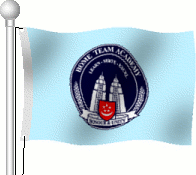 The
Home Team Academy (HTA) began operations in 2006 bringing together the
various training establishments of the Home Team services into one single
complex. The HTA houses and generally oversees the training of police,
prisons, and immigration officers of all ranks, and specially manages
inter-agency programmes. Former training establishments included the
Police Academy, the Prisons Staff Training School, and the ICA Academy. Despite the Home
Team reference, Civil Defence
personnel continue to undergo training at the separate Civil
Defence Academy (see
section 2.7B.III). The Home Team Cadet Corps
headquarters is also now housed at the Home Team Academy and several
training sessions for the cadets are also conducted at the HTA. The Home
Team Cadet Corps is comprised of the National Police Cadet Corps and the
National Civil Defence Cadet Corps (see section 2.9B
and 2.9C) which was previously based at the Police
Academy. The
Home Team Academy (HTA) began operations in 2006 bringing together the
various training establishments of the Home Team services into one single
complex. The HTA houses and generally oversees the training of police,
prisons, and immigration officers of all ranks, and specially manages
inter-agency programmes. Former training establishments included the
Police Academy, the Prisons Staff Training School, and the ICA Academy. Despite the Home
Team reference, Civil Defence
personnel continue to undergo training at the separate Civil
Defence Academy (see
section 2.7B.III). The Home Team Cadet Corps
headquarters is also now housed at the Home Team Academy and several
training sessions for the cadets are also conducted at the HTA. The Home
Team Cadet Corps is comprised of the National Police Cadet Corps and the
National Civil Defence Cadet Corps (see section 2.9B
and 2.9C) which was previously based at the Police
Academy.
The
HTA's flag has a plain light blue field charged with the predominantly
dark blue logo of the academy at the centre as displayed on the left. The
HTA logo is derived from the logo of the Ministry of Home Affairs (MHA).
The central feature of the logo are the two towers, which is a depiction of
the buildings that houses the headquarters of the Home Affairs Ministry and
the Singapore Police
Force, located at New Phoenix Park. The red shield with the
white crescent and stars being the arms of Singapore. The scroll on the
HTA logo carries the motto "Honour & Unity", which are the
core values of the Home Team as a whole. A second motto
appears above the towers in an arc, which reads "Learn, Serve, Excel".
Laurels flank the right and left of the logo. The logo also carries the
name of the academy at its top. The flag can be seen hoisted at the main
entrance of the academy.
As
a multi-service installation, the flags of the various agencies of the
Home Team are flown at the academy premises. At the academy's open house
in September 2006, the flags were seen hoisted in the following order: the
Singapore Police Force flag, the Singapore Prison Service flag (section
2.6), the Internal Security Department flag (section
2.8D), the Central Narcotics Bureau flag (section
2.8C), the Singapore Civil Defence Force flag (section
2.7A), and the Immigration and Checkpoints Authority flag (section
2.8B). The Singapore Corporation of Rehabilitative Enterprise
(SCORE), a civilian statutory board, is also represented with an
organisational flag that is hoisted between the flags of the Central Narcotics Bureau
and the Singapore Civil Defence Force.
A
formal official opening ceremony of the academy was held in conjunction
with the open house as mentioned above. A parade was held as part of the
formal ceremonies and the service flags of the Singapore Police Force,
Internal Security Department, Singapore Civil Defence Force, Singapore
Prison Service, Immigration & Checkpoints
Authority, Central Narcotics Bureau, as well as the Home Team Academy flag were paraded together in
that given order. The arrangement adopted for the parade was notably
different from the hoisting order as adopted for the flag poles mentioned
above.
[Return
to Directory] |
|
2.6 -
Singapore Prison Service |
|
The Singapore
Prison Service (SPS) is responsible for the secure detention and
rehabilitation of criminal offenders in Singapore. The Prisons Service is
also referred to as the Prisons Department interchangeably.
2.6A - The
Prisons Department Service Flag
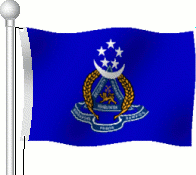 The
Prisons service flag is in their corporate colours of blue with their
emblem in full colour charged in the centre. The Prisons emblem features a
gold lion passant guardant beneath two gold keys in saltire, all of which appears
within an equilateral blue-framed triangle, that displays in white the
text, "Security,
Humanity, Rehabilitation" on each side. The triangle is flanked on
its left and right by gold laurels. Surmounting all of these is the
crescent and five stars from the arms
of Singapore, but without
the red shield unlike the other services. Beneath it all is a blue
scroll bearing the service name, "Singapore Prison Service" in white. Keys
in saltire and the lion passant guardant were also used by the predecessor
colonial prison service mentioned in the following entry. The
Prisons service flag is in their corporate colours of blue with their
emblem in full colour charged in the centre. The Prisons emblem features a
gold lion passant guardant beneath two gold keys in saltire, all of which appears
within an equilateral blue-framed triangle, that displays in white the
text, "Security,
Humanity, Rehabilitation" on each side. The triangle is flanked on
its left and right by gold laurels. Surmounting all of these is the
crescent and five stars from the arms
of Singapore, but without
the red shield unlike the other services. Beneath it all is a blue
scroll bearing the service name, "Singapore Prison Service" in white. Keys
in saltire and the lion passant guardant were also used by the predecessor
colonial prison service mentioned in the following entry.
From an
enquiry to the Singapore Prisons Service, the emblem was designed in 1964/1965. Accordingly, the lion, crescent, and stars represent
the national status of the service. The crossed keys represent
imprisonment of offenders under lock and key. The equilateral triangle
represents the equal importance of Humanity, Security, and Rehabilitation,
which is their service mission. The paddy laurels represent the peace of
the nation. The Prisons service is the only service that does not use the shield
proper of the national arms as part of its service emblem adopting only
the charges of the national arms.
The Prison service
flag is flown in second position to the national flag and it is
displayed from sunrise to sunset at their installations. The proportion of
the flag is 2:3. At the Home Team Academy, the service flag of the Prisons
Department is hoisted second to the Police service flag (2.5D).
2.6B - Former
Prisons Emblem
The Prisons
Service like many services in Singapore, had its beginnings during the
colonial period. Before the merger in 1963, they existed under the same
name, "Singapore Prison Service". They had a badge for their uniforms and
it was also used on their magazine, Majalah Penjara. It featured
a lion passant guardant on a turf with a palm tree as a backdrop. This was
likely a partial reference to the Crest of the City of Singapore. However, the
city crest depicted a lion passant and not a lion passant guardant. A lion
passant guardant was used as a charge on the shield of the colony coat of arms. There
were also two keys in saltire (diagonal cross) as part of the backdrop. These charges
were
garlanded within laurels and also within a contiguous chain. A scroll with the name of
the service, "Singapore Prison Service" appears at the base of the emblem.
Her Majesty's St Edward's crown surmounts the badge. The date of its
adoption and the badge of the service from 1959 to 1965 are uncertain.
[Return
to Directory] |
|
2.7 -
Singapore Civil Defence Force |
|
The Singapore
Civil Defence Force (SCDF) is responsible for the provision of rescue
services, fire-fighting services, national emergency ambulance services, air-raid
shelters management, and educating the public about civil protection skills
and procedures. The Public Warning System is also managed by the SCDF. The
SCDF is an unarmed organisation.
2.7A - The Singapore Civil
Defence Force Service Flag
 The SCDF service flag has an
orange field with the SCDF emblem in full colour in the centre. The SCDF
emblem features the State shield, representing the national status of the
force, on the blue international Civil Defence triangle, representing
fire-fighting, rescue, and first aid concepts of Civil Defence. Green
laurels attached to its base a red ribbon signifying honour of service to
the nation flanks the triangle. A blue scroll appears beneath with the inscription
"Singapore Civil Defence" in white. Officially, the colour blue
represents loyalty. The SCDF service flag has an
orange field with the SCDF emblem in full colour in the centre. The SCDF
emblem features the State shield, representing the national status of the
force, on the blue international Civil Defence triangle, representing
fire-fighting, rescue, and first aid concepts of Civil Defence. Green
laurels attached to its base a red ribbon signifying honour of service to
the nation flanks the triangle. A blue scroll appears beneath with the inscription
"Singapore Civil Defence" in white. Officially, the colour blue
represents loyalty.
The service
flag is flown in second position to the national flag and is displayed
from sunrise to sunset at their installations. The proportion of the
service flag and unit flags are 2:3. The SCDF also have flags for its
various units and formations, which takes third position when flown
together. The
exact date of adoption is uncertain. The earliest dated picture with such
a flag seen so far is that on National Day Parade of 1985, when the SCDF
contingent paraded their service flag. Something to note however is that the SCDF
service flag of 1985 had the first SCDF emblem which was rendered slightly
differently from today's.
The
equilateral blue triangle on an orange field is an emblem
of protection as governed by the Geneva Convention of 1949 relating
to the Protection of
Victims of International Armed Conflicts (Protocol 1 - Adopted in June
1977). Specifically, the relevant paragraphs are:
“The international distinctive sign of civil defence is an
equilateral blue triangle on an orange ground when used for the
protection of civil defence organizations, their personnel, buildings
and material and for civilian shelters.” Part IV, Chapter VI -
Civil Defence, Article 66, Paragraph 4.
“It is recommended that: (a) If the blue triangle is
on a flag or armlet or tabard, the ground to the triangle be the orange
flag, armlet or tabard; (b) One of the angles of the triangle be pointed
vertically upwards; (c) No angle of the triangle touch the edge of the
orange ground.” Annex I, Chapter V - Civil Defence, Article 15,
Paragraph 2.
As mentioned earlier under entry 2.5A.Ia, several units of the Police
and Civil Defence forces share common premises at Alexandra, where the service
flags of both services are thus flown alongside one another with
SCDF's taking precedence over that of the SPF's. At the Home Team Academy, the SCDF flag is hoisted
in sixth position amongst the flags of the Home Team agencies (2.5D)
- this excludes the position of the national flag.
2.7A.I - The Histories of
Civil Defence and Fire Service Organisations,
and their Emblems Unlike
the colonial police forces, the civil defence and fire service organisations
of the colonial period did not use the badge of the colony (the crown/s and
pall reversed) in their service badges. Instead, the crest and arms of the city and colony were
featured on their badges. Where flags are concerned, these
organisations did not seem to have service flags during the colonial period.
There were actually such flags in the UK, although they
were in existence only temporarily at times for combined war effort
purposes. Under normal circumstances, these services are localised
services. There
were flags for the
UK
Civil Defence adopted in 1943 and also the UK
National Fire Service adopted in 1942. These flags followed the
ensign-styled flags of the navy and air force but were quartered; the Union
Flag appearing in the canton and the service badge or insignia at the lower fly /
fourth quarter. As Singapore's colonial
fire service and civil defence services do not seem to have been equipped with such service flags,
the influence in design did not seem to have managed to filter through. These
quartered flags would have probably made flags much more visually
interesting rather than the common badge on a plain field flag like today.
2.7A.Ia - Singapore Fire Brigade (1888 - 1980), Singapore Fire
Service (1980 - 1992)
Singapore first began with a Singapore Fire Brigade during
the colonial period, established around 1888. The
Singapore Fire Brigade remained in service since then and was
renamed
Singapore Fire Service in 1980. For a badge, the Singapore Fire
Brigade used the crest of the Arms of the City, featuring the lion statant
and a coconut palm tree.
The Fire Service emblem (date of
adoption possibly 1980) was quite similar to the first SCDF emblem, as it
featured similar laurel wreath and scroll. The central device was the red State shield
surmounted with an orange colonial-style
fire helmet on two blue axes in saltire. Their blue scroll reads
"Singapore Fire Service". It is uncertain however if they had
any service flag then. In 1939, in
light of the approaching war, a volunteer unit known as the Auxiliary
Fire Service (AFS) was set up and managed by the Singapore Fire Brigade.
The AFS was eventually reintroduced after WW2 under the newly laid civil
defence plans for the colony. 2.7A.Ib - Singapore Civil Defence Corps (1951 - 1959)
A Singapore Civil
Defence Corps was raised by the colonial government through a May 1951
Ordinance. It operated with two reserve units namely the AFS
reintroduced in 1952 and the Auxiliary Health Service (AHS). The
Civil Defence Corps was disbanded in 1959. The AFS remained until 1960
(absorbed by the Singapore Fire Brigade) while the AHS was transferred
to the Ministry of Health. The
Civil Defence Corps badge was similar to those used in the United
Kingdom.
The badge comprised a circular title-scroll with the text "Civil Defence
Corps" and an additional scroll at the base with the text
"Singapore". The Arms of the Colony of Singapore, featuring
the lion passant guardant on a tower, appeared at the centre of the badge
within the title-scroll.
The badge was completed with the royal crown surmounting the
title-scroll. 2.7A.Ic - Singapore Civil Defence Force (since 1982)
In 1982, a
Civil Defence Command was established under the Singapore Police Force.
It was renamed Singapore Civil Defence Force in 1983. The Civil Defence
Act passed in 1986, made SCDF a proper independent force with a Civil
Defence Commissioner. In 1989, the Singapore Civil Defence Force and
Singapore Fire Service merged to form the Singapore Joint Civil Defence
Forces (SJCDF). The SCDF emblem was retained after the merger. The name
of the force reverted back to 'SCDF' in 1992.
The first
SCDF emblem then was however slightly different in the rendering of the
laurels and scroll. Notably, the laurels then had a stalk, unlike
today's. The scroll back then comprised only two fold-points, compared to
today's four fold-points. These features were also prevalent on the Singapore
Fire Service emblem before it was retired upon the merger. The use of
the current emblem on documents was in late 1988. Although the
Singapore Fire Service emblem was retired, personnel who are
fire-trained still bear the helmet and axes badge of the former Fire
Service, on their uniforms.
2.7B - The Singapore
Civil Defence Force Unit & Formation Flags
As
mentioned, the administration & operations of SCDF are divided into its
four territorial Divisions, each with a Divisional Headquarters and its
assigned Fire Stations. Headquarters SCDF does not have a unit flag. The
unit emblems were first introduced in early 2000. There is a parade version
for all the units and formations listed below which basically appears with
additional gold fringes and attached to a pike/staff (Refer to Page 2, Section
4.6B). 2.7B.I -
SCDF Unit Flags (Division Headquarters)
Basically,
the flags of the Division HQs & Fire Stations will reflect the
colour as assigned to the entire Division. The assigned colours are yellow,
blue, green and red for 1st, 2nd, 3rd, and 4th Divisions respectively.
For Division
HQs, their unit emblem is a white disc, bordered with the official
division colours. A white equilateral triangle is superimposed
on the disc throughout that basically divides the coloured border into three
equal parts. On the left and right border segments are laurels. The base
segment of the border has the inscription of the
Division's name in white. The peak of the triangle contains a stylised depiction of the
abbreviation "CD". The centre
has depictions of animals assigned to the Division; a dragon for 1st CD
Division, a gryphon for 2nd CD Division, an eagle for 3rd CD Division,
and a puma for 4th CD Division.
2.7B.II - SCDF Unit Flags (Fire
Stations)
For
the Fire Stations, the unit emblems feature a common standard template.
There is to be a shield with the words "Fire Station"
in white at the top. Beneath the words "Fire Station" is where the
name of the Fire Station is placed. Within the shield at its base
are laurels with a ribbon. All these common features shall be in
the colours as assigned to the division the station belongs to.
The
centre of the shield is where charges associated with fire, rescue, and
ambulance services are displayed. They include fire-fighting
equipments such as helmets, nozzles, axes, hydrants & fire vehicles,
images of fire fighters, chemical
hazard classification quadrants, flames, the fire station number, a skyline of area where the station serves, and the emergency medical
services star of life emblem. The fire station emblem is charged on a plain
coloured field to make the unit flag.
The
blue six-barred Star of Life is the badge of the emergency medical
services, which was first, designed by Leo R. Schwartz, the Chief of
the EMS Branch of the United States' National Highway Traffic Safety
Administration (NHTSA) in 1977 as a suitable replacement for the
restricted-use international Red Cross
emblem. The blue star has at its centre in gold/yellow, the Rod of
Aesculapius, featuring a staff encircled with a snake/serpent.
Aesculapius was the ancient Greek god of medicine. See also mention of
the Rod of Aesculapius and the Caduceus in Section 2.8A (Singapore Customs) on this page, and on
Section
4.3B.I & 4.3B.II.j
(Singapore Armed Forces Medical Corps) on Page 2.
Several
stations incorporate the station number on their emblems, such as
Central (1), Clementi (4), Bishan (5), and Changi (8) Fire Stations.
Jurong Fire Station places an axe in the form of the number 7 on their
emblem as a reflection of their station number. As at 2003, the
order as stated below was used by the SCDF and the
flags have been arranged according to this numbering sequence. Several stations were renamed when they shifted to
new premises. The name of the station as appearing on the station logo
was thus changed. The former name is placed in parentheses in the table where this is the
case. Tuas FS was renamed without a shift in premises and before the
station emblems were adopted. Serangoon Fire
Station was formerly under the management of Headquarters 2nd CD Division and their
divisional colours for the flag's field and station logo template were formerly
blue. The divisional colours were changed to yellow when they relocated and was subsequently reorganised under 1st CD Division. SCDF
has since adopted new a numbering convention for its stations combining
division number and station precedence, thus Central Fire Station is
today referred to as Station 11 (1st station of 1st CD Division). The
new numbering convention causes some anomaly with logos that had
originally incorporated the original numbering system. For instance, the
8th fire station, Changi FS, is now Station 22 (2nd station of 2nd CD
Division). The original numbering system and order as used up to 2003/4 has been retained here
so as to
match the station number appearing on the emblems. This order has also
been kept when the unit parade flags are paraded at Civil Defence Day Parades.
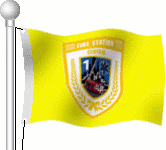 |
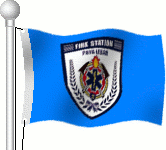 |
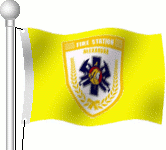 |
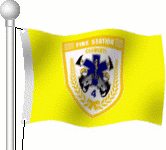 |
| 01)
Central F.S. |
02)
Paya Lebar F.S.
(Geylang F.S.) |
03)
Alexandra F.S. |
04)
Clementi F.S. |
 |
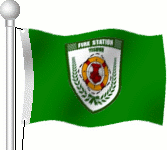 |
 |
 |
05)
Bishan F.S.
(Serangoon F.S.) |
06) Yishun
F.S.
(Sembawang F.S.) |
07) Jurong
F.S. |
08) Changi
F.S. |
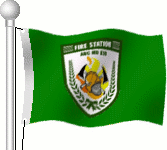 |
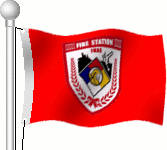 |
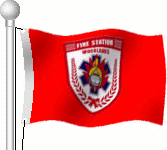 |
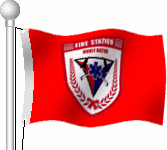 |
| 09) Ang Mo Kio
F.S. |
10) Tuas
F.S.
(Jurong West F.S.) |
11) Woodlands
F.S. |
12) Bukit Batok
F.S.
(Bukit Timah F.S.) |
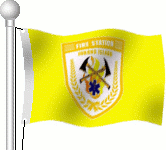 |
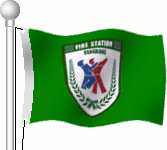 |
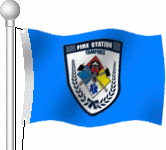 |
Future
Fire Stations:
- Banyan F.S.
- Marina F.S. |
| 13) Jurong Island
F.S. |
14) Sengkang
F.S. |
15) Tampines F.S. |
|
2.7B.III - SCDF Unit Flags
(Training Establishments)
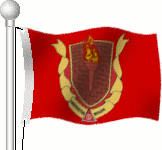 The
two training establishments of the SCDF are the Civil Defence Academy
(CDA) and the Basic Rescue Training Centre (BRTC). Since
mid-2006, the two units have been co-located and the premises designated
as the CDA Complex. The
two training establishments of the SCDF are the Civil Defence Academy
(CDA) and the Basic Rescue Training Centre (BRTC). Since
mid-2006, the two units have been co-located and the premises designated
as the CDA Complex.
Prior to the relocation to its new
premises, the BRTC had a unit flag and emblem as shown on the right. The former emblem of the
Basic Rescue Training Centre (BRTC) was made up of a shield and
scroll. The shield's field is made up of brown bricks, representing the
Construction Brigade upon which is charged a flaming torch, a
traditional symbol of the quest for knowledge, BRTC being the provider
of basic rescue training education. 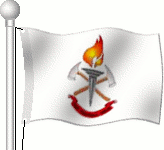 The shield is flanked left to right
all around its base with a yellow scroll bearing the inscription
"Construction Brigade". The white abbreviation of CD on a red
triangle appears at the base of the shield. The emblem is placed on a
red field to make the BRTC unit flag. A parade version was also
available in a similar design with the addition of gold fringes. The shield is flanked left to right
all around its base with a yellow scroll bearing the inscription
"Construction Brigade". The white abbreviation of CD on a red
triangle appears at the base of the shield. The emblem is placed on a
red field to make the BRTC unit flag. A parade version was also
available in a similar design with the addition of gold fringes.
A new emblem and flag for BRTC was adopted
upon the unit's relocation to its new premises as shown on the left. The new emblem comprises two axes in saltire behind a
flaming torch. 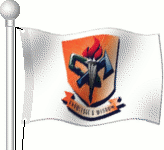 The emblem
is charged on a plain white field to make the current unit flag. BRTC is where all conscripts
assigned to the Civil Defence scheme of service is trained in basic rescue, first aid and
basic fire fighting, before being posted for secondary specialist
training at CDA or thereafter posted directly to units. CDA is also the
training centre for officers of the Force. The emblem
is charged on a plain white field to make the current unit flag. BRTC is where all conscripts
assigned to the Civil Defence scheme of service is trained in basic rescue, first aid and
basic fire fighting, before being posted for secondary specialist
training at CDA or thereafter posted directly to units. CDA is also the
training centre for officers of the Force.
The emblem of the Civil Defence Academy (CDA)
features an orange shield, the charges on which are an axe and a carabineer
in saltire upon which is placed a flaming torch with rays. Beneath the shield is a
motto-scroll bearing the inscription, "Knowledge &
Wisdom". The CDA emblem is placed on a white field to make the unit
flag as shown on the right. The CDA unit flag takes precedence over BRTC's unit flag when
they are on parade together.
A a closer view of the
emblems of the Division HQs and Fire Stations is available at the SCDF website
here.
|
|
2.7B.IV - SCDF Formation Flags (Special Units)
There are two formation flags
in the SCDF. One of which belongs to the elite Disaster Assistance
& Rescue Team (DART) and the other to the Special
Rescue Battalion (SRB). Both formation flags for general
use has an orange field and
is charged with their formation emblems at the centre. These flags are
not flown on flagpoles as far as I know. Like the other SCDF Units
mentioned above, there are also parade flags for these two
formations. The Parade/Indoor Flag version for DART retains the
original design, an orange field with the DART emblem in the centre
and the flag is fringed in gold. The SRB parade flag differs from the
general-use formation flag in that the field of the parade flag is white
and not orange. The SRB emblem is charged at the centre of the white
field and the parade flag is fringed in gold. These parade flags are
shown on Page 2, Section 4.6B.
The DART emblem basically
shows a rescuer rappelling with a high-rise rescue stretcher. Their motto "We Dare" is inscribed on a scroll at
the base of their emblem. The SRB emblem reflects their multiple
functions. The chemical quadrant table base reflecting their roles in
hazardous materials training, a helmet for their fire fighting
functions, a red cross for their first-aid duties and axes in saltire
and ropes representing their rescue function. Their motto is
"Always Ready" and this appears on a scroll at the base of
their emblem.
[Return
to Directory] |
|
2.8 - The
Other National Enforcement Agencies |
|
As
mentioned in the introduction, the Home Team is comprised of several
agencies under the jurisdiction of the Ministry of Home Affairs. The two
main agencies with clear paramilitary characteristics are the Singapore
Police Force and the Singapore Civil Defence Force, and to an extent the
Singapore Prison Service as well. This section will note the other
agencies that have been established to do enforcement work in specific
areas. Regimentation is not a central feature of these services,
although some are uniform-wearing services. The rank structures for these
services (except ISD) have been incorporated in the Military and
Paramilitary Ranks of Singapore site.
2.8A -
Singapore
Customs
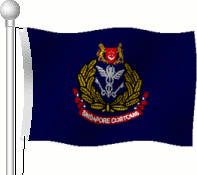 Singapore Customs is a department under the Ministry of Finance. They were formerly known
as the Singapore Customs and Excise Department (CED), which had its
existence since the colonial period. In April 2003, part of the duties of the
CED was transferred to the Singapore Immigration and Registration (SIR),
which was reorganised to become the Immigration and Checkpoints Authority (ICA). Singapore Customs and Excise Department was reorganised
into Singapore
Customs hence. Singapore Customs is a department under the Ministry of Finance. They were formerly known
as the Singapore Customs and Excise Department (CED), which had its
existence since the colonial period. In April 2003, part of the duties of the
CED was transferred to the Singapore Immigration and Registration (SIR),
which was reorganised to become the Immigration and Checkpoints Authority (ICA). Singapore Customs and Excise Department was reorganised
into Singapore
Customs hence.
The current
Singapore Customs emblem (appearing on the current service flag as shown
on the left) is the third in its history, adopted in April
2003, upon the reorganisation of the former CED. The first Customs service
emblem
was similar in design to the emblem used by the Polis Negara Singapura
(See Section 2.5B.III on this page).
The fronds were yellow, within which was the State shield. The ribbons
and scroll were blue and the scroll had the inscription "Singapore Customs
Excise". The date of adoption is uncertain, but it was used by the
department until 1968. It is uncertain if they had a service flag then.
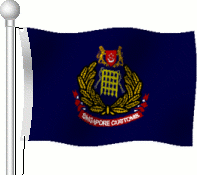 The second
Customs emblem was adopted in 1968, and is the basis of the current
Customs emblem. It featured the gold fronds, the portcullis and a red
scroll at its base, inscribed with "Singapore Customs". The
emblem is surmounted with the national arms but without the motto-scroll,
"Majulah Singapura". The use of the nearly complete achievement of
the present arms is unlike the other enforcement services (exception of
Prisons and ISD) who uses only the shield of arms. A portcullis is a
heavy grilled door with spikes at the bottom, used to guard the main
entrance of a castle. The
portcullis is said to "represent the gates of the kingdom, that is the
seaports; which were of course the seats of operations of the Customs."
(The Portcullis: The House of Commons Information Office, Factsheet G9
General Series, September 2003). The department had a service
flag, which featured this Customs & Excise emblem on a plain navy
blue field. The second Customs emblem and service flag was in use until
April 2003 (Former service flag & emblem as shown on the right). The second
Customs emblem was adopted in 1968, and is the basis of the current
Customs emblem. It featured the gold fronds, the portcullis and a red
scroll at its base, inscribed with "Singapore Customs". The
emblem is surmounted with the national arms but without the motto-scroll,
"Majulah Singapura". The use of the nearly complete achievement of
the present arms is unlike the other enforcement services (exception of
Prisons and ISD) who uses only the shield of arms. A portcullis is a
heavy grilled door with spikes at the bottom, used to guard the main
entrance of a castle. The
portcullis is said to "represent the gates of the kingdom, that is the
seaports; which were of course the seats of operations of the Customs."
(The Portcullis: The House of Commons Information Office, Factsheet G9
General Series, September 2003). The department had a service
flag, which featured this Customs & Excise emblem on a plain navy
blue field. The second Customs emblem and service flag was in use until
April 2003 (Former service flag & emblem as shown on the right).
The third and
present Customs emblem replaces the portcullis from the second emblem with
that of a silver Caduceus and two silver keys. The caduceus is the
staff of Hermes (Greek) / Mercury (Roman), featuring a rod, entwined by two snakes/serpents
and topped with a pair of wings. Hermes / Mercury was regarded by these
ancient communities as the god of
commerce and travel. Customs, as the facilitator of trade and travel, thus
uses the befitting Caduceus as its emblem. The two keys represent
the desire to achieve higher levels of trade facilitation while ensuring
revenue protection. The entire emblem is charged on a navy blue field to
make the current service flag. This flag can be seen at Revenue House, flying
alongside the national flag. The proportion of the flag is 2:3.
The Caduceus is also commonly used to represent medical organisations
although the more accurate charge should be the Rod of Aesculapius
(as
used by the SCDF as mentioned on Section
2.7B.II on this page). The Caduceus is thus also used as the insignia of the SAF
Medical Corps (Refer to Page 2, Section 4.3B.I & 4.3B.II.j).
Internationally, Customs agencies popularly use two devices for its
emblem, either the portcullis or the caduceus.
2.8B - Immigration & Checkpoints
Authority (ICA)
 The Immigration and
Checkpoints Authority (ICA) was established on 1st April 2003, from the
merger of the former Singapore Immigration and Registration and part of
the Singapore Customs and Excise Department. The ICA is an agency under
the jurisdiction of the Ministry of Home Affairs, thus part of the Home
Team. The Immigration and
Checkpoints Authority (ICA) was established on 1st April 2003, from the
merger of the former Singapore Immigration and Registration and part of
the Singapore Customs and Excise Department. The ICA is an agency under
the jurisdiction of the Ministry of Home Affairs, thus part of the Home
Team.
Both departments held a joint
competition to find a new emblem for ICA and the one that is seen today
was the adopted entry. Their emblem features the State shield representing
the national status of the authority. The centre is charged with a
portcullis, on a red segment representing the land. The emblem is
garlanded with laurels and has a blue scroll at the base inscribed with
"Immigration and Checkpoints Authority" in white.
Their service flag has a plain white
field and is charged with the ICA emblem in the centre. The flag can be seen hoisted alongside
the national flag at the ICA Headquarters and checkpoint complexes. The proportion
of the flag is 2:3. At the Home Team Academy, the ICA flag is hoisted in
seventh position amongst the various flags of the Home Team agencies (2.5D)
- this excludes the position of the national flag. Vessels of
the ICA flies the State Marine Ensign as mentioned earlier (2.5C.I).
ICA vessels also fly their service pennant onboard, a blue
triangular flag with the the text "ICA" above a smaller sized
text "Singapore", both texts appearing in white letters. A
similar flag but with a blue field instead of white has been seen hoisted
at the ICA Building; the reasoning for this difference at the moment
unclear.
2.8C - Central
Narcotics Bureau (CNB)
The CNB has a service flag that
is flown at the Home Team Academy. The flag comprises a dark blue field
and the CNB service emblem charged at its centre. The CNB emblem features elements
of the police service emblem as mentioned in 2.5A. A
silver 8-pointed starburst forms the base of the emblem on which its
centre is charged with the wreath and shield of the national arms like
those appearing on the police emblem. The name of the department - Central Narcotics
Bureau, Singapore - encircles the wreath and arms. Like other flags, the
CNB flag is in the proportions of 2:3. At the Home Team Academy, the CNB
flag is hoisted in fourth position amongst the various flags of the Home
Team agencies (2.5D) - this excludes the
position of the national flag. The CNB is considered a Home Team Uniformed
Service
like the Police, Prison, and Civil Defence services.
2.8D - Internal
Security Department (ISD)
At the Home Team Academy, the
ISD is also represented with a flag of their own flown alongside the other
service flags of the Home Team services. The ISD flag comprises a white
field charged with the ISD emblem at its centre. The ISD emblem is simply
the national arms, in its complete current achievement depiction, with the gold text
"Internal Security Department" placed above the national arms in
an arc. As
per other flags, the proportion of the ISD flag is 2:3. The ISD flag takes
third position amongst the various flags of the Home Team agencies (2.5D)
- this excludes the position for national flag.
[Return
to Directory] |
|
2.9 - The
Cadet Corps of Singapore |
|
The youth cadet corps have been
in existence since the colonial period such as the School Cadet Corps (Army), Sea Cadet Corps
and the Air Training Corps. The Police Cadet Corps was only established
later while Singapore was a self-governing colony. In 2005, the Civil Defence
Cadet Corps was officially established. The Police and Civil Defence Cadet
Corps are also referred to as the Home Team Cadet Corps, but retaining
their separate identities.
The other uniformed youth organisations in
Singapore are the Boys Brigade Singapore, Girls Brigade Singapore, Girl
Guide Singapore, Singapore Scouts Association, Red Cross Youth, and St
John Ambulance Brigade, each having their own flags and varying practices
as well. At the 2006 Singapore Youth Festival Opening Ceremony parade, the
uniformed youth organisations' general flags were paraded together in the
order listed above with those of the national corps preceding the rest -
specifically NPCC's followed by NCC's (joint organisational flag only) and
followed by NCDCC's.
2.9A - National Cadet Corps (NCC)
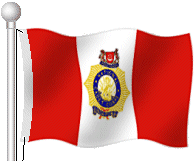 The National Cadet Corps (NCC) is Singapore's own local uniformed
organisation for youths, that began as the Army Cadet Corps in the 1900s. Administered
jointly by the Ministry of Education and the SAF, they set to provide youths with
various skills that classrooms can't offer and a feel and introduction to
the life in the SAF as well. Like the SAF, there are three 'services' in
the NCC. They are the NCC Land, NCC Sea and NCC Air. The National Cadet Corps (NCC) is Singapore's own local uniformed
organisation for youths, that began as the Army Cadet Corps in the 1900s. Administered
jointly by the Ministry of Education and the SAF, they set to provide youths with
various skills that classrooms can't offer and a feel and introduction to
the life in the SAF as well. Like the SAF, there are three 'services' in
the NCC. They are the NCC Land, NCC Sea and NCC Air.
 The NCC as a unified organisation is represented with an NCC
Joint Organisational Flag and each of the NCC branches have their
individual Organisational Flag. The NCC as a unified organisation is represented with an NCC
Joint Organisational Flag and each of the NCC branches have their
individual Organisational Flag.
The NCC joint/unified organisational
flag is a vertical triband of red-white-red charged in the central
white band, with the NCC emblem. The NCC emblem is a starburst surmounted
with the full State Arms. Within the blue ring, which is inscribed with
"National Cadet Corps" in gold, is a lion rampant holding a sword, all in
gold. A blue scroll inscribed with "Singapore" in gold is placed on a red
ribbon at the base of the starburst. The flag is in the proportions of
2:3. It is referred to more commonly as the NCC Tri-Service Banner.
The NCC-Land organisational
flag has a green field and the NCC Joint Organisational Flag in the
canton. The lower fly is defaced with the NCC-Land insignia, a bayonet and
a torch. The NCC-Land only received an Organisational Flag on July 10,
1999. Previously, the NCC Land used the joint banner to represent
themselves.
The NCC-Sea organisational
flag has a navy blue field and the NCC-Joint Flag in
the canton. The lower fly is defaced with the NCC-Sea insignia, a white
anchor with gold ropes. The NCC-Sea Banner was granted in 1982. The lower fly is defaced with the NCC-Sea insignia, a white
anchor with gold ropes. The NCC-Sea Banner was granted in 1982.
The NCC-Air organisational
flag has a light blue field and
the NCC-Joint Flag in the canton. The lower fly is defaced with the
NCC-Air insignia, an eagle. The date of adoption is uncertain.
The full arrangement of flags
when displayed is the national flag, SAF Flag, Ministry of Education Flag,
the NCC-Joint Flag, the NCC-Land Flag, the NCC-Sea Flag and the NCC-Air
Flag.
In addition to the Organisational
Flags, the NCC also have ceremonial flags. The NCC has accredited the
status of their ceremonial flags as Colours. The NCC Colours are
mentioned in further detail in Section 4.6C on Page
2.
|
|
2.9B - National Police Cadet Corps
(NPCC)
 There
is also a Police variant of the cadet corps, for those more interested in
policing. Their purpose is the same as the NCC, which is to equip various
skills to the cadets and introduce them to the life in the Singapore
Police Force. The Ministry of Education jointly administers the NPCC with
the Singapore Police Force and the Ministry of Home Affairs. For some time,
the NPCC was administered as part of the NCC (known then as the NCC Police),
until the Ministry of Defence and the Interior split to become the
Ministry of Defence and the Ministry of Home Affairs respectively. Whilst
under the NCC, their badge for their headgear was that of the NCC. There
is also a Police variant of the cadet corps, for those more interested in
policing. Their purpose is the same as the NCC, which is to equip various
skills to the cadets and introduce them to the life in the Singapore
Police Force. The Ministry of Education jointly administers the NPCC with
the Singapore Police Force and the Ministry of Home Affairs. For some time,
the NPCC was administered as part of the NCC (known then as the NCC Police),
until the Ministry of Defence and the Interior split to become the
Ministry of Defence and the Ministry of Home Affairs respectively. Whilst
under the NCC, their badge for their headgear was that of the NCC.
The NPCC organisational flag for general use is an equal horizontal bicolour, navy blue over white. The
canton is charged with the NPCC emblem. The NPCC emblem is the SPF emblem
but the scroll of the latter is replaced with a scroll inscribed with 'NPCC'
for the Corps. Additionally, the date 1959 (the formation of the first
unit in NPCC's history) appears beneath the scroll. The lower white half
of the flag is inscribed with "National Police Cadet Corps" in blue, nearer to its
base. There is also an NPCC Ceremonial Flag mentioned further in Section 4.6D on Page 2.
|
|
2.9C - National
Civil Defence Cadet Corps (NCDCC)
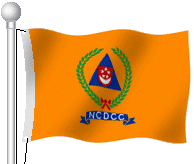 The National Civil Defence Cadet Corps was established in 2005, with the
aim of instilling civil defence skills and knowledge to youths. Like the
NPCC, the Ministry of Education, Ministry of Home Affairs and the
Singapore Civil Defence Force administer the NCDCC jointly. The National Civil Defence Cadet Corps was established in 2005, with the
aim of instilling civil defence skills and knowledge to youths. Like the
NPCC, the Ministry of Education, Ministry of Home Affairs and the
Singapore Civil Defence Force administer the NCDCC jointly.
The NCDCC emblem is derived from that of the SCDF's
with the scroll of the latter replaced with a blue one bearing the
initials NCDCC for the corps instead. The NCDCC emblem thus has equivalent
symbolism to that of SCDF's. The NCDCC emblem is placed on an orange field
to make their organisational flag. As mentioned under the entry on the
SCDF, the blue triangle on an orange field is an international symbol and
colours for civil defence organisations as governed by the Geneva
Convention.
A
parade version of the flag is available and paraded at the Singapore Youth
Festival opening parade. It is in the exact design as the organisational
flag shown here but the ceremonial flag is completed with a gold fringe
and attached to a wooden staff.
|
|
[Return
to Directory] •
[Proceed to
Page 2] •
[Military
& Paramilitary Ranks of Singapore] |
 The
British Union Flag was the official flag of the Straits Settlements. The
Straits Settlements also had a blue colonial ensign defaced with a badge.
Its use spanned from 1826 to 1946 (World War II: Japanese Interregnum 1942
to 1945). The badge of the Straits Settlements was a red lozenge, charged with a white inverted pall
- a heraldic charge in the form of the letter 'Y'. On each arm is charged an
imperial crown. The badge was used for government purposes but was
not officially authorised however.
The
British Union Flag was the official flag of the Straits Settlements. The
Straits Settlements also had a blue colonial ensign defaced with a badge.
Its use spanned from 1826 to 1946 (World War II: Japanese Interregnum 1942
to 1945). The badge of the Straits Settlements was a red lozenge, charged with a white inverted pall
- a heraldic charge in the form of the letter 'Y'. On each arm is charged an
imperial crown. The badge was used for government purposes but was
not officially authorised however. On
25th March 1911, the Arms of the Colony of the Straits Settlements was
granted by warrant. The Arms was comprised of a quartered shield bearing the following
charges representing each settlement in the following order:
On
25th March 1911, the Arms of the Colony of the Straits Settlements was
granted by warrant. The Arms was comprised of a quartered shield bearing the following
charges representing each settlement in the following order:  It
was mentioned in several sources that the Singapore Municipal Commission
used a device to represent themselves in the form of a lion statant with a
coconut palm tree all on a green turf as illustrated here on the right.
The origins and status of this badge is however unclear. It was referred
to as the Crest of the Municipal Commission often but there does not seem
to be any arms (shield and charges) for the Commission. Nonetheless, this emblem was also adopted
in the badge of the
Singapore Volunteer Corps from 1928 onwards. It was retained after the war as the crest of the new City of Singapore Arms
granted in 1948 as shown below. The lion statant (both paws grounded) was
however changed to a lion passant (a paw raised) depiction. The Singapore Volunteer Corps
Regimental Colour of 1954 featured this device with the lion that was
adopted remaining at statant position.
It
was mentioned in several sources that the Singapore Municipal Commission
used a device to represent themselves in the form of a lion statant with a
coconut palm tree all on a green turf as illustrated here on the right.
The origins and status of this badge is however unclear. It was referred
to as the Crest of the Municipal Commission often but there does not seem
to be any arms (shield and charges) for the Commission. Nonetheless, this emblem was also adopted
in the badge of the
Singapore Volunteer Corps from 1928 onwards. It was retained after the war as the crest of the new City of Singapore Arms
granted in 1948 as shown below. The lion statant (both paws grounded) was
however changed to a lion passant (a paw raised) depiction. The Singapore Volunteer Corps
Regimental Colour of 1954 featured this device with the lion that was
adopted remaining at statant position. The
coat of arms for the City of Singapore was granted by letters
patent on 9th April 1948. It featured the gold lion passant guardant on
a white tower as per the first quarter of the Arms of the Straits Settlements.
There appears a gold chief partitioned by embattlement, on which is
charged a pair of blue wings between two blue anchors, representing the trade
hub role of Singapore. The Arms of the City
used the crest of the Singapore Municipal Commission, a lion statant with a palm
tree. On the new city arms' crest however, the lion was depicted as a lion
passant (a paw raised) and not in statant (both paws on ground) position. There was also a yellow motto-scroll inscribed with
"Majulah Singapura" ("Let Singapore Flourish") probably added later. This became the motto and title of the
national anthem of the present Republic. The arms as illustrated here were
shown in the Singapore Annual Report with an all-blue mantling, and an
esquire's silver helm. The wreath for the crest was depicted in
blue. The lion passant and coconut palm crest was used in the cap badge of the Singapore
Fire Brigade and Auxiliary Fire Service placed on the traditional emergency services
starburst and was used for quite sometime after independence as well. There
were also instances where the Singapore Fire Brigade used a lion statant
guardant (both paws grounded and head turned to face viewer) with the palm
tree rather than the lion passant, notably for the badge on the fire helmet. The
colonial prison service used as part of their badge the crest but
replacing the lion passant with the lion passant guardant (a paw raised
and head turned to face viewer) like the lion as depicted on the shield.
The
coat of arms for the City of Singapore was granted by letters
patent on 9th April 1948. It featured the gold lion passant guardant on
a white tower as per the first quarter of the Arms of the Straits Settlements.
There appears a gold chief partitioned by embattlement, on which is
charged a pair of blue wings between two blue anchors, representing the trade
hub role of Singapore. The Arms of the City
used the crest of the Singapore Municipal Commission, a lion statant with a palm
tree. On the new city arms' crest however, the lion was depicted as a lion
passant (a paw raised) and not in statant (both paws on ground) position. There was also a yellow motto-scroll inscribed with
"Majulah Singapura" ("Let Singapore Flourish") probably added later. This became the motto and title of the
national anthem of the present Republic. The arms as illustrated here were
shown in the Singapore Annual Report with an all-blue mantling, and an
esquire's silver helm. The wreath for the crest was depicted in
blue. The lion passant and coconut palm crest was used in the cap badge of the Singapore
Fire Brigade and Auxiliary Fire Service placed on the traditional emergency services
starburst and was used for quite sometime after independence as well. There
were also instances where the Singapore Fire Brigade used a lion statant
guardant (both paws grounded and head turned to face viewer) with the palm
tree rather than the lion passant, notably for the badge on the fire helmet. The
colonial prison service used as part of their badge the crest but
replacing the lion passant with the lion passant guardant (a paw raised
and head turned to face viewer) like the lion as depicted on the shield.
 A new badge to be used on the colonial ensign was thus
granted as well. It was basically a revision of the Straits Settlements
lozenge badge. The colour order was reversed - now bearing a white field
with a red pall reversed, the overall shape of the badge changed from a lozenge to a disc, and the number of crowns reduced from three to one. The blue ensign with the new badge was used henceforth until 1959,
when Singapore attained self-government status. The crowns featured on the
colonial ensigns should have been changed from the previously used
imperial (also known as Tudor) design to the current St Edward's design
by order of Her Majesty Queen Elizabeth II in 1953. The flag featuring the
new badge was used as
the naval ensign of the Malayan Royal Naval Volunteer Reserve and the
Malayan Naval Force. The Marine Police also flew the blue ensign charged
with this badge on their vessels. The colonial police force of
Singapore accordingly updated their former Straits Settlements Police service badge
upon the change of the colonial badge but only slightly.
A new badge to be used on the colonial ensign was thus
granted as well. It was basically a revision of the Straits Settlements
lozenge badge. The colour order was reversed - now bearing a white field
with a red pall reversed, the overall shape of the badge changed from a lozenge to a disc, and the number of crowns reduced from three to one. The blue ensign with the new badge was used henceforth until 1959,
when Singapore attained self-government status. The crowns featured on the
colonial ensigns should have been changed from the previously used
imperial (also known as Tudor) design to the current St Edward's design
by order of Her Majesty Queen Elizabeth II in 1953. The flag featuring the
new badge was used as
the naval ensign of the Malayan Royal Naval Volunteer Reserve and the
Malayan Naval Force. The Marine Police also flew the blue ensign charged
with this badge on their vessels. The colonial police force of
Singapore accordingly updated their former Straits Settlements Police service badge
upon the change of the colonial badge but only slightly. Singapore
was allowed to have a new (the present) flag and coat of arms, which were
adopted in December of that year (components detailed in Part
ii of Chapter 2 below). The Singapore State Marine Ensign was
tabled a year later in the Legislative Assembly. The British Union Flag
& colonial ensign remained in use for certain purposes. (E.g. as the
naval ensign and jack)
Singapore
was allowed to have a new (the present) flag and coat of arms, which were
adopted in December of that year (components detailed in Part
ii of Chapter 2 below). The Singapore State Marine Ensign was
tabled a year later in the Legislative Assembly. The British Union Flag
& colonial ensign remained in use for certain purposes. (E.g. as the
naval ensign and jack) The
The
 The tri-service training institute of the SAF is known as SAFTI
Military Institute. It is the only establishment of the SAF to have
a formation flag hoisted on a pole alongside the military service flags. The flag
is made up of a
plain red field on which is charged the SAFTI M.I. insignia; a torch and a broadsword in
saltire, flanked on its left and right by green palm fronds. A blue scroll
appears beneath and is inscribed with the motto of the institute: "To Lead,
To Excel, To Overcome", in yellow text. The flag is in the proportions of
2:3.
The tri-service training institute of the SAF is known as SAFTI
Military Institute. It is the only establishment of the SAF to have
a formation flag hoisted on a pole alongside the military service flags. The flag
is made up of a
plain red field on which is charged the SAFTI M.I. insignia; a torch and a broadsword in
saltire, flanked on its left and right by green palm fronds. A blue scroll
appears beneath and is inscribed with the motto of the institute: "To Lead,
To Excel, To Overcome", in yellow text. The flag is in the proportions of
2:3.
 The current Army
service flag has a yellow field with the canton (1st quarter of a flag's
layout) from the canton of the national flag, and the SAF emblem charged in
the lower fly (4th quarter of a flag's layout).
The current Army
service flag has a yellow field with the canton (1st quarter of a flag's
layout) from the canton of the national flag, and the SAF emblem charged in
the lower fly (4th quarter of a flag's layout).  The SAF emblem used on the current service
flag is now equivalent to the
SAF
emblem on the SAF Joint-Service flag as shown previously in 2.1. The SAF emblem that
appears on the former Army Flag is slightly different from the one that
appears on the SAF Joint-Service flag and current Army service
flag. Notably, the wreath is green & thicker
(likely palm fronds) and the emblem features an additional red
ribbon.
The SAF emblem used on the current service
flag is now equivalent to the
SAF
emblem on the SAF Joint-Service flag as shown previously in 2.1. The SAF emblem that
appears on the former Army Flag is slightly different from the one that
appears on the SAF Joint-Service flag and current Army service
flag. Notably, the wreath is green & thicker
(likely palm fronds) and the emblem features an additional red
ribbon.
 The RSN
service flag is white and the red canton is from the
canton of the national flag. The lower fly is charged with a red stylised
8-pointed cardinal device (termed 'Mariner's Compass'). This
flag is derived from the Singapore Naval Ensign. Ensigns are a special
category of flags flown at sea for status differentiation - merchant or
civil vessels, military service vessels or non-military government service
vessels.
The RSN
service flag is white and the red canton is from the
canton of the national flag. The lower fly is charged with a red stylised
8-pointed cardinal device (termed 'Mariner's Compass'). This
flag is derived from the Singapore Naval Ensign. Ensigns are a special
category of flags flown at sea for status differentiation - merchant or
civil vessels, military service vessels or non-military government service
vessels.
 2.3B.I - The RSN Naval Jack
2.3B.I - The RSN Naval Jack

 The
precedence of flags on a flag pole with a yardarm and gaff is as follow:
the gaff, the peak, the port yardarm (the left arm), and the starboard
yardarm (the right arm). For poles with yardarm but without a gaff, the
peak is the primary position, followed by the port then starboard
yardarms. These pennants are thus flown at the junior-most position.
The
precedence of flags on a flag pole with a yardarm and gaff is as follow:
the gaff, the peak, the port yardarm (the left arm), and the starboard
yardarm (the right arm). For poles with yardarm but without a gaff, the
peak is the primary position, followed by the port then starboard
yardarms. These pennants are thus flown at the junior-most position.  Singapore was, from 1819 to 1963, under the
administration of the United Kingdom.
Singapore was, from 1819 to 1963, under the
administration of the United Kingdom.  The Straits Settlements NVR was established in
April 1934 with the main division in the settlement of Singapore. In
October 1938, the Penang branch was established. The Force was initially
not 'Royal' as it was not under the jurisdiction of the British
Admiralty. 'Royal' was only added from 1936 onwards, when it began to be
listed by the Admiralty.
The Straits Settlements NVR was established in
April 1934 with the main division in the settlement of Singapore. In
October 1938, the Penang branch was established. The Force was initially
not 'Royal' as it was not under the jurisdiction of the British
Admiralty. 'Royal' was only added from 1936 onwards, when it began to be
listed by the Admiralty.  In July
1948, the Malayan RNVR was re-formed in the Colony of
Singapore. The Malayan RNVR was later reconstituted as a joint force
comprising of the Singapore Division and the Federation Division, by an
Ordinance passed in Singapore in 1952.
In July
1948, the Malayan RNVR was re-formed in the Colony of
Singapore. The Malayan RNVR was later reconstituted as a joint force
comprising of the Singapore Division and the Federation Division, by an
Ordinance passed in Singapore in 1952.  The federation of Malaysia was formed in 1963 (comprising of
the Federation of Malaya, Singapore, Sabah, & Sarawak). The Royal
Malayan Navy was thus renamed the Royal Malaysian Navy or in Malay, Tentera Laut
Di-Raja Malaysia
(TLDM).
The federation of Malaysia was formed in 1963 (comprising of
the Federation of Malaya, Singapore, Sabah, & Sarawak). The Royal
Malayan Navy was thus renamed the Royal Malaysian Navy or in Malay, Tentera Laut
Di-Raja Malaysia
(TLDM). The current RSAF
service flag is light blue with the
canton of the national flag for its canton, and the RSAF roundel charged
in the lower fly. The roundel of the RSAF shows a red lion-head symbol
with five distinct mane partings. This current version was adopted in
1990.
The current RSAF
service flag is light blue with the
canton of the national flag for its canton, and the RSAF roundel charged
in the lower fly. The roundel of the RSAF shows a red lion-head symbol
with five distinct mane partings. This current version was adopted in
1990.

 The RSAF had two former
service flags prior to 1990, which respectively followed the histories of
the air force roundels.
The RSAF had two former
service flags prior to 1990, which respectively followed the histories of
the air force roundels.

 The
Police service flag is in their corporate colours of
navy blue, with the SPF emblem rendered in white in the centre. The actual
coloured Police emblem has the red State shield within the blue and white
garlands of paddy-sheaths held together with blue ribbons. A blue scroll
appears below, with the name of the force in the national language
(Malay), "Polis Repablik Singapura" translated as Republic of Singapore
Police. Apparently, another variant of the
Police service flag
has the shield white and the stars in blue. Both
versions are official designs.
The
Police service flag is in their corporate colours of
navy blue, with the SPF emblem rendered in white in the centre. The actual
coloured Police emblem has the red State shield within the blue and white
garlands of paddy-sheaths held together with blue ribbons. A blue scroll
appears below, with the name of the force in the national language
(Malay), "Polis Repablik Singapura" translated as Republic of Singapore
Police. Apparently, another variant of the
Police service flag
has the shield white and the stars in blue. Both
versions are official designs.  In 1946,
Singapore's status became that of a crown colony by itself with the
reorganisation of the British possessions in Malaya which involved the
dissolving of the Straits Settlements. The badge of the
Colony of Singapore now featured a single crown (instead of three), on a
red pall reversed (instead of a white pall reversed), on a
white disc (instead of a red lozenge). The
scroll on the police badge then bore "Singapore Police Force". The
emblem of the Police still retained the lozenge despite the change
of the ensign badge defacement from a lozenge to a disc. The badge appeared on the front covers of their quarterly publications
(Singapore
Police Magazine) up to the 1959 September issue. In 1953,
In 1946,
Singapore's status became that of a crown colony by itself with the
reorganisation of the British possessions in Malaya which involved the
dissolving of the Straits Settlements. The badge of the
Colony of Singapore now featured a single crown (instead of three), on a
red pall reversed (instead of a white pall reversed), on a
white disc (instead of a red lozenge). The
scroll on the police badge then bore "Singapore Police Force". The
emblem of the Police still retained the lozenge despite the change
of the ensign badge defacement from a lozenge to a disc. The badge appeared on the front covers of their quarterly publications
(Singapore
Police Magazine) up to the 1959 September issue. In 1953,
 In 1959,
Singapore attained self-government status and in December of the year,
also introduced the new State Arms. This affected the Police badge and
it henceforth featured for the first time ever, the shield as appearing
on the present national arms. The scroll however bore the inscription in
Malay, Polis Negara Singapura, generally translated as
"State of Singapore Police". "Negara" generally translates to
"nation-state" in English. The new
Police emblem began to appear on the covers of their quarterly
publications (Singapore Police Magazine) since the December 1959 issue.
The badge was placed on a blue field to make the service flag of the
police for that
period. Like the previous police flag, there seems to be different
arrangement of the title-scroll for different uses of the service badge.
In 1959,
Singapore attained self-government status and in December of the year,
also introduced the new State Arms. This affected the Police badge and
it henceforth featured for the first time ever, the shield as appearing
on the present national arms. The scroll however bore the inscription in
Malay, Polis Negara Singapura, generally translated as
"State of Singapore Police". "Negara" generally translates to
"nation-state" in English. The new
Police emblem began to appear on the covers of their quarterly
publications (Singapore Police Magazine) since the December 1959 issue.
The badge was placed on a blue field to make the service flag of the
police for that
period. Like the previous police flag, there seems to be different
arrangement of the title-scroll for different uses of the service badge.
 In September
1963, Singapore attained independence from the United Kingdom as a
component state
within the federation of Malaysia. The police
forces of Malaya, Singapore, Sabah, and Sarawak were thus integrated to
become the new Polis Di-Raja Malaysia (Royal Malaysia Police). As
such, the Royal Malaysian Police badge (1963 - 1965) was used in
Singapore and on the Police service flag.
In September
1963, Singapore attained independence from the United Kingdom as a
component state
within the federation of Malaysia. The police
forces of Malaya, Singapore, Sabah, and Sarawak were thus integrated to
become the new Polis Di-Raja Malaysia (Royal Malaysia Police). As
such, the Royal Malaysian Police badge (1963 - 1965) was used in
Singapore and on the Police service flag.

 The
Home Team Academy (HTA) began operations in 2006 bringing together the
various training establishments of the Home Team services into one single
complex. The HTA houses and generally oversees the training of police,
prisons, and immigration officers of all ranks, and specially manages
inter-agency programmes. Former training establishments included the
Police Academy, the Prisons Staff Training School, and the ICA Academy. Despite the Home
Team reference, Civil Defence
personnel continue to undergo training at the separate Civil
Defence Academy
The
Home Team Academy (HTA) began operations in 2006 bringing together the
various training establishments of the Home Team services into one single
complex. The HTA houses and generally oversees the training of police,
prisons, and immigration officers of all ranks, and specially manages
inter-agency programmes. Former training establishments included the
Police Academy, the Prisons Staff Training School, and the ICA Academy. Despite the Home
Team reference, Civil Defence
personnel continue to undergo training at the separate Civil
Defence Academy  The
Prisons service flag is in their corporate colours of blue with their
emblem in full colour charged in the centre. The Prisons emblem features a
gold lion passant guardant beneath two gold keys in saltire, all of which appears
within an equilateral blue-framed triangle, that displays in white the
text, "Security,
Humanity, Rehabilitation" on each side. The triangle is flanked on
its left and right by gold laurels. Surmounting all of these is the
crescent and five stars from the
The
Prisons service flag is in their corporate colours of blue with their
emblem in full colour charged in the centre. The Prisons emblem features a
gold lion passant guardant beneath two gold keys in saltire, all of which appears
within an equilateral blue-framed triangle, that displays in white the
text, "Security,
Humanity, Rehabilitation" on each side. The triangle is flanked on
its left and right by gold laurels. Surmounting all of these is the
crescent and five stars from the  The SCDF service flag has an
orange field with the SCDF emblem in full colour in the centre. The SCDF
emblem features the State shield, representing the national status of the
force, on the blue international Civil Defence triangle, representing
fire-fighting, rescue, and first aid concepts of Civil Defence. Green
laurels attached to its base a red ribbon signifying honour of service to
the nation flanks the triangle. A blue scroll appears beneath with the inscription
"Singapore Civil Defence" in white. Officially, the colour blue
represents loyalty.
The SCDF service flag has an
orange field with the SCDF emblem in full colour in the centre. The SCDF
emblem features the State shield, representing the national status of the
force, on the blue international Civil Defence triangle, representing
fire-fighting, rescue, and first aid concepts of Civil Defence. Green
laurels attached to its base a red ribbon signifying honour of service to
the nation flanks the triangle. A blue scroll appears beneath with the inscription
"Singapore Civil Defence" in white. Officially, the colour blue
represents loyalty.
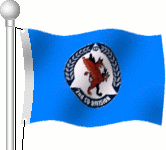

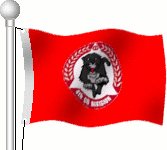















 The
two training establishments of the SCDF are the Civil Defence Academy
(CDA) and the Basic Rescue Training Centre (BRTC). Since
mid-2006, the two units have been co-located and the premises designated
as the CDA Complex.
The
two training establishments of the SCDF are the Civil Defence Academy
(CDA) and the Basic Rescue Training Centre (BRTC). Since
mid-2006, the two units have been co-located and the premises designated
as the CDA Complex. The shield is flanked left to right
all around its base with a yellow scroll bearing the inscription
"Construction Brigade". The white abbreviation of CD on a red
triangle appears at the base of the shield. The emblem is placed on a
red field to make the BRTC unit flag. A parade version was also
available in a similar design with the addition of gold fringes.
The shield is flanked left to right
all around its base with a yellow scroll bearing the inscription
"Construction Brigade". The white abbreviation of CD on a red
triangle appears at the base of the shield. The emblem is placed on a
red field to make the BRTC unit flag. A parade version was also
available in a similar design with the addition of gold fringes. The emblem
is charged on a plain white field to make the current unit flag. BRTC is where all conscripts
assigned to the Civil Defence scheme of service is trained in basic rescue, first aid and
basic fire fighting, before being posted for secondary specialist
training at CDA or thereafter posted directly to units. CDA is also the
training centre for officers of the Force.
The emblem
is charged on a plain white field to make the current unit flag. BRTC is where all conscripts
assigned to the Civil Defence scheme of service is trained in basic rescue, first aid and
basic fire fighting, before being posted for secondary specialist
training at CDA or thereafter posted directly to units. CDA is also the
training centre for officers of the Force. Singapore Customs is a department under the Ministry of Finance. They were formerly known
as the Singapore Customs and Excise Department (CED), which had its
existence since the colonial period. In April 2003, part of the duties of the
CED was transferred to the Singapore Immigration and Registration (SIR),
which was reorganised to become the Immigration and Checkpoints Authority (ICA). Singapore Customs and Excise Department was reorganised
into Singapore
Customs hence.
Singapore Customs is a department under the Ministry of Finance. They were formerly known
as the Singapore Customs and Excise Department (CED), which had its
existence since the colonial period. In April 2003, part of the duties of the
CED was transferred to the Singapore Immigration and Registration (SIR),
which was reorganised to become the Immigration and Checkpoints Authority (ICA). Singapore Customs and Excise Department was reorganised
into Singapore
Customs hence. The second
Customs emblem was adopted in 1968, and is the basis of the current
Customs emblem. It featured the gold fronds, the portcullis and a red
scroll at its base, inscribed with "Singapore Customs". The
emblem is surmounted with the national arms but without the motto-scroll,
"Majulah Singapura". The use of the nearly complete achievement of
the present arms is unlike the other enforcement services (exception of
Prisons and ISD) who uses only the shield of arms.
The second
Customs emblem was adopted in 1968, and is the basis of the current
Customs emblem. It featured the gold fronds, the portcullis and a red
scroll at its base, inscribed with "Singapore Customs". The
emblem is surmounted with the national arms but without the motto-scroll,
"Majulah Singapura". The use of the nearly complete achievement of
the present arms is unlike the other enforcement services (exception of
Prisons and ISD) who uses only the shield of arms.  The Immigration and
Checkpoints Authority (ICA) was established on 1st April 2003, from the
merger of the former Singapore Immigration and Registration and part of
the Singapore Customs and Excise Department. The ICA is an agency under
the jurisdiction of the Ministry of Home Affairs, thus part of the Home
Team.
The Immigration and
Checkpoints Authority (ICA) was established on 1st April 2003, from the
merger of the former Singapore Immigration and Registration and part of
the Singapore Customs and Excise Department. The ICA is an agency under
the jurisdiction of the Ministry of Home Affairs, thus part of the Home
Team.
 The National Cadet Corps (NCC) is Singapore's own local uniformed
organisation for youths, that began as the Army Cadet Corps in the 1900s. Administered
jointly by the Ministry of Education and the SAF, they set to provide youths with
various skills that classrooms can't offer and a feel and introduction to
the life in the SAF as well. Like the SAF, there are three 'services' in
the NCC. They are the NCC Land, NCC Sea and NCC Air.
The National Cadet Corps (NCC) is Singapore's own local uniformed
organisation for youths, that began as the Army Cadet Corps in the 1900s. Administered
jointly by the Ministry of Education and the SAF, they set to provide youths with
various skills that classrooms can't offer and a feel and introduction to
the life in the SAF as well. Like the SAF, there are three 'services' in
the NCC. They are the NCC Land, NCC Sea and NCC Air.  The NCC as a unified organisation is represented with an NCC
Joint Organisational Flag and each of the NCC branches have their
individual Organisational Flag.
The NCC as a unified organisation is represented with an NCC
Joint Organisational Flag and each of the NCC branches have their
individual Organisational Flag. 
 The lower fly is defaced with the NCC-Sea insignia, a white
anchor with gold ropes. The NCC-Sea Banner was granted in 1982.
The lower fly is defaced with the NCC-Sea insignia, a white
anchor with gold ropes. The NCC-Sea Banner was granted in 1982. There
is also a Police variant of the cadet corps, for those more interested in
policing. Their purpose is the same as the NCC, which is to equip various
skills to the cadets and introduce them to the life in the Singapore
Police Force. The Ministry of Education jointly administers the NPCC with
the Singapore Police Force and the Ministry of Home Affairs. For some time,
the NPCC was administered as part of the NCC (known then as the NCC Police),
until the Ministry of Defence and the Interior split to become the
Ministry of Defence and the Ministry of Home Affairs respectively.
There
is also a Police variant of the cadet corps, for those more interested in
policing. Their purpose is the same as the NCC, which is to equip various
skills to the cadets and introduce them to the life in the Singapore
Police Force. The Ministry of Education jointly administers the NPCC with
the Singapore Police Force and the Ministry of Home Affairs. For some time,
the NPCC was administered as part of the NCC (known then as the NCC Police),
until the Ministry of Defence and the Interior split to become the
Ministry of Defence and the Ministry of Home Affairs respectively. 